WHY DO NATIONS TRADE? GOALS OF CLASS

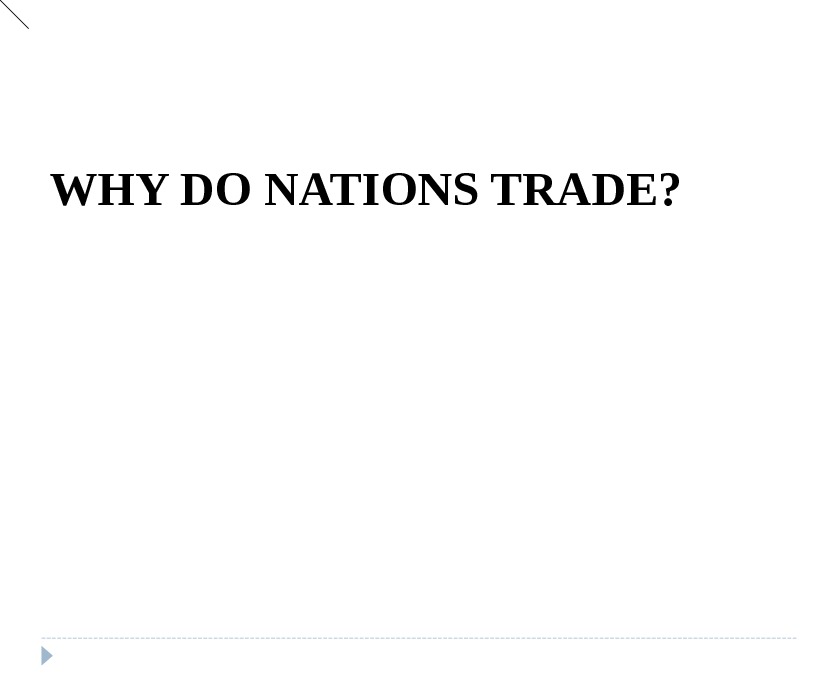
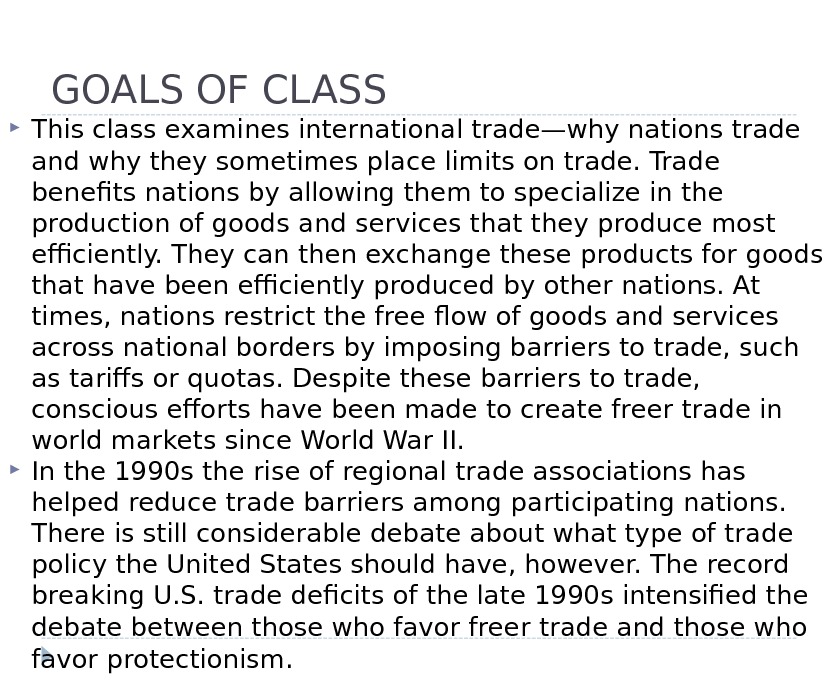
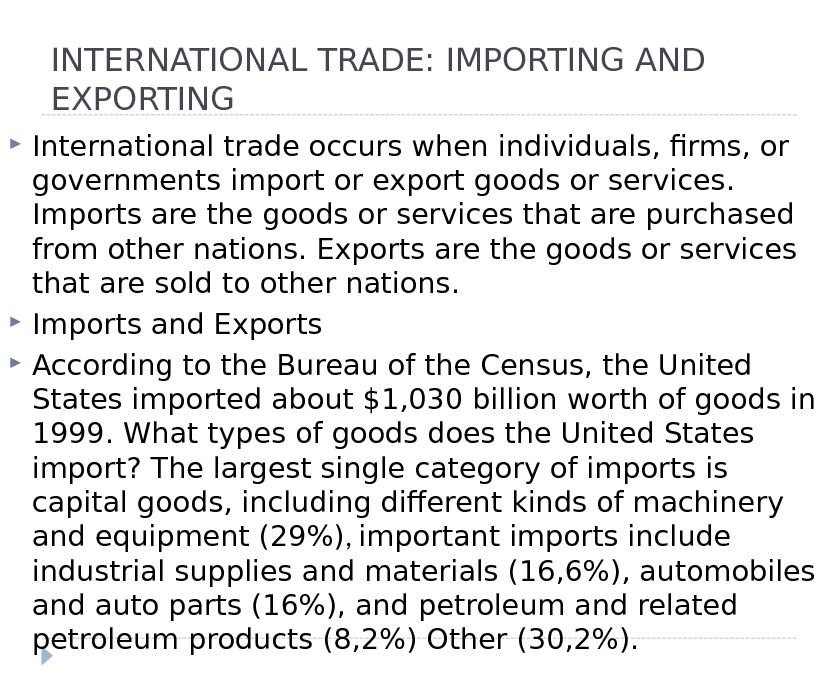
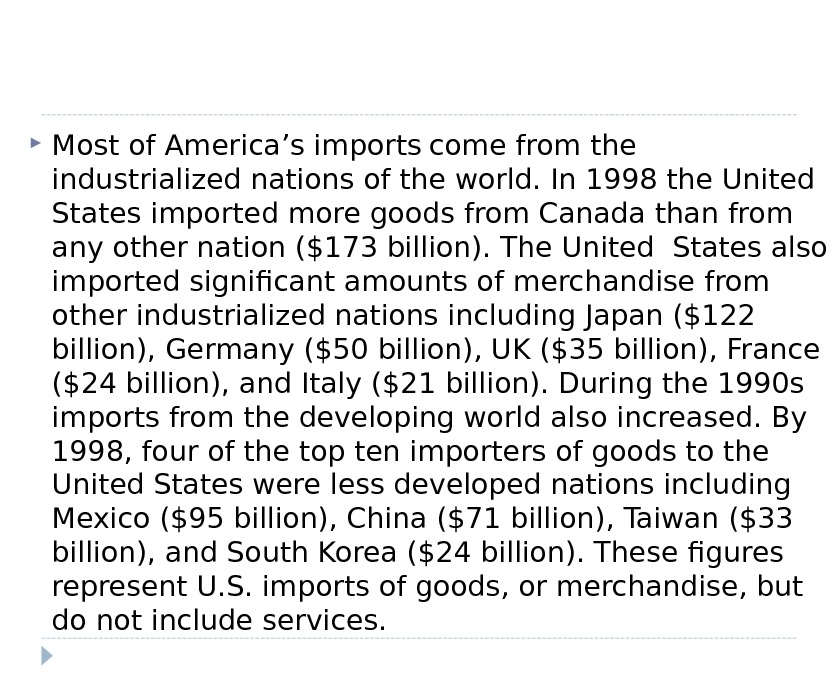
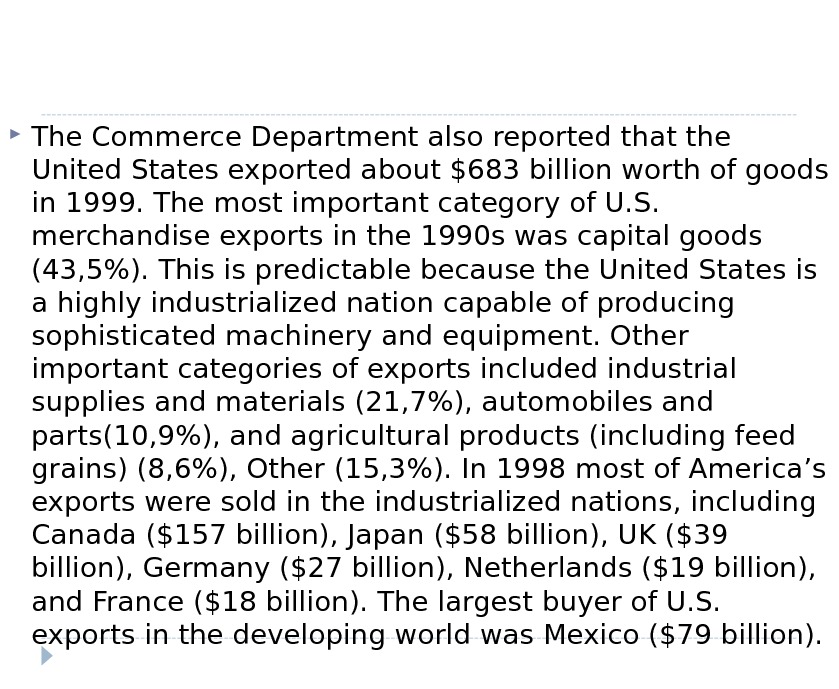
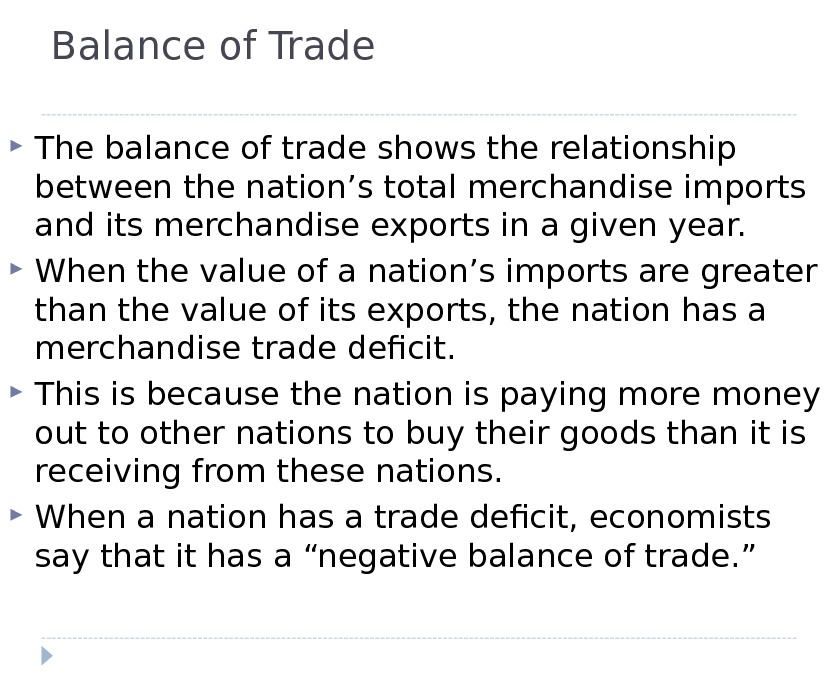
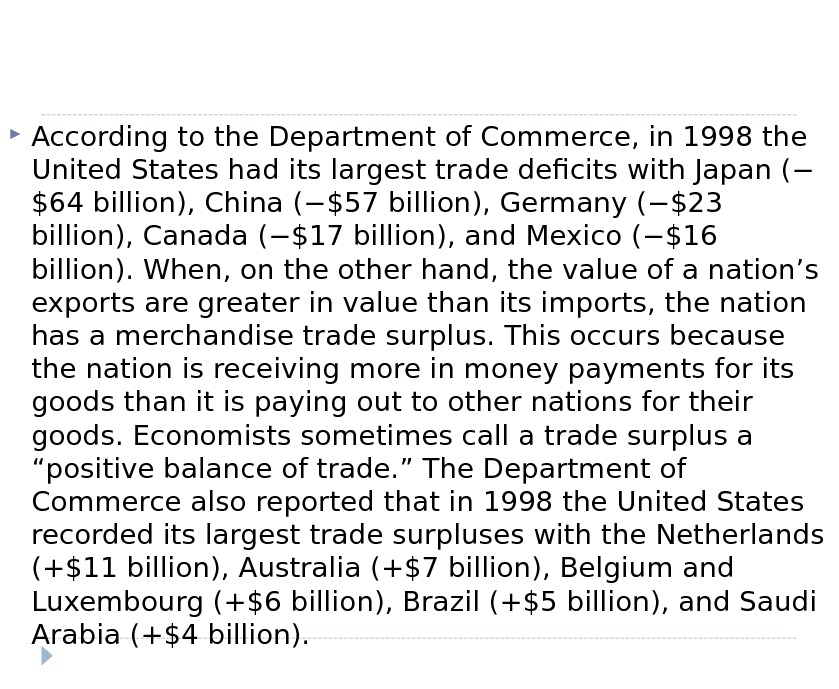
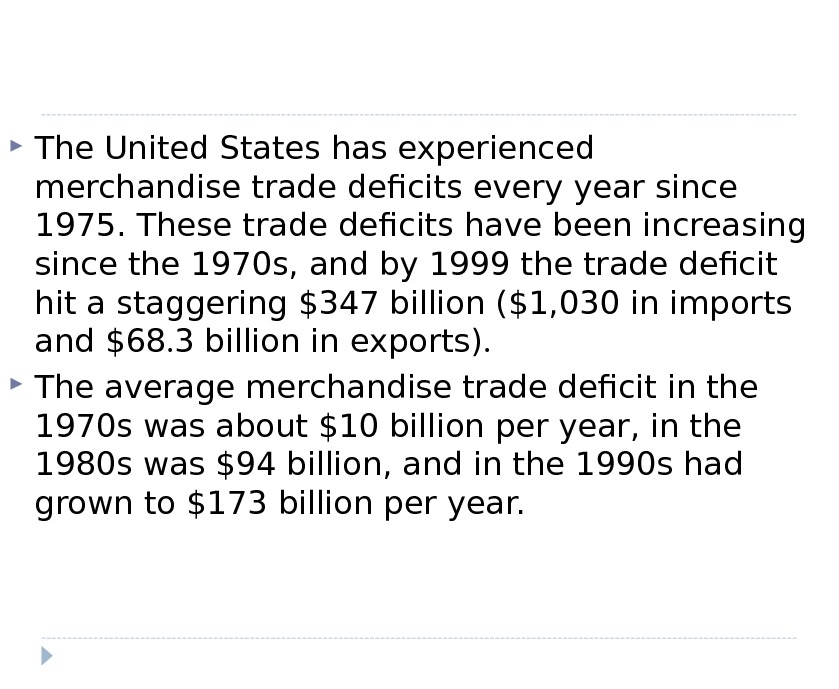

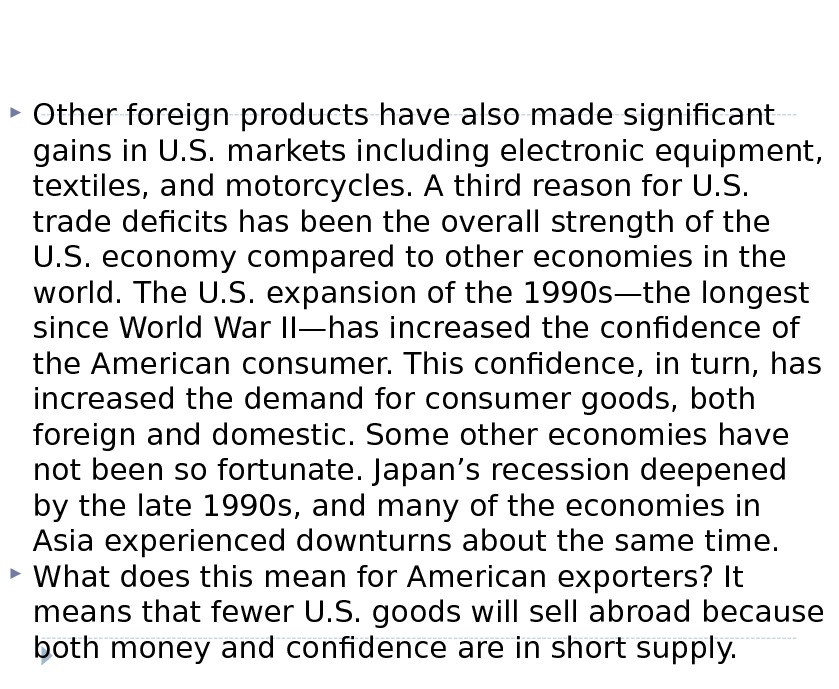
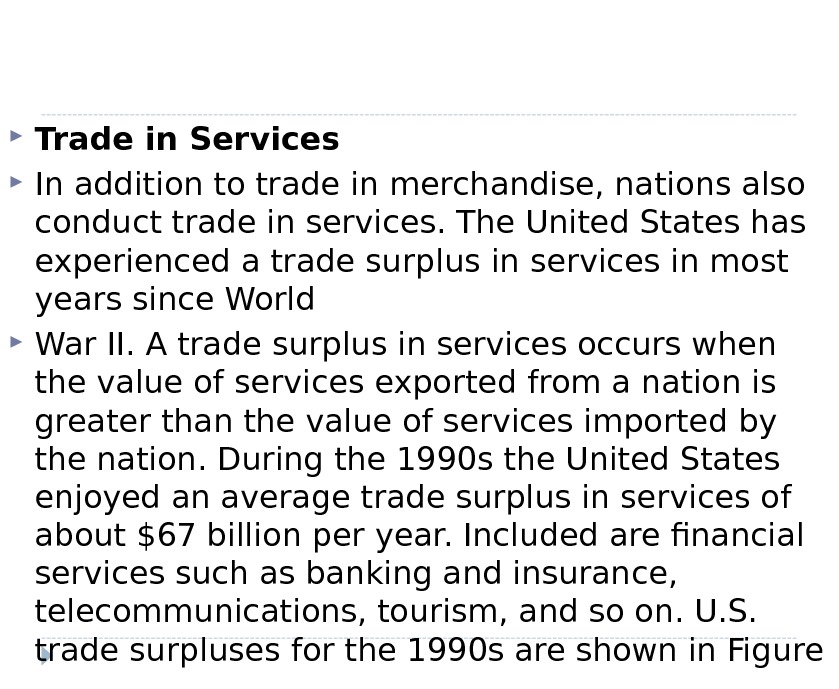
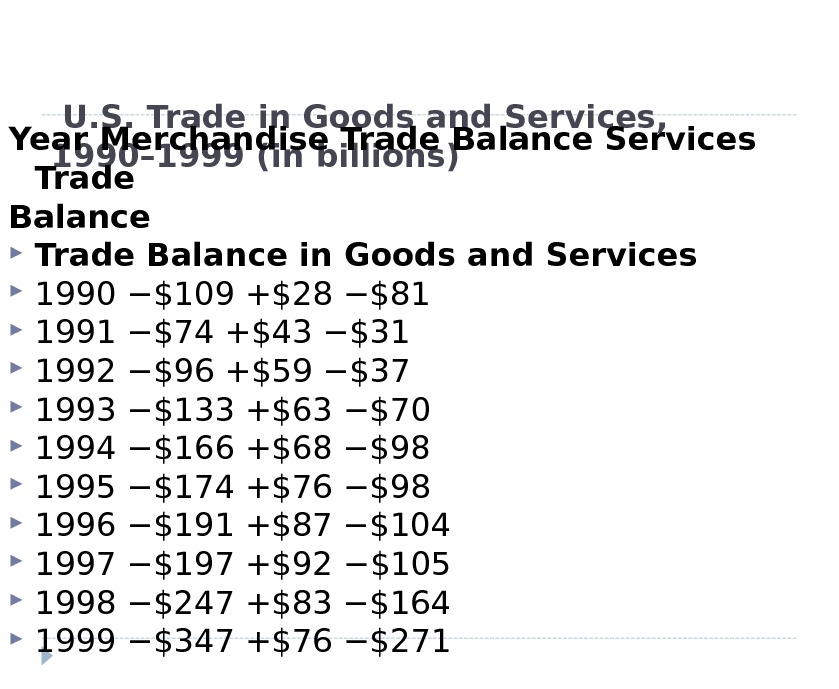
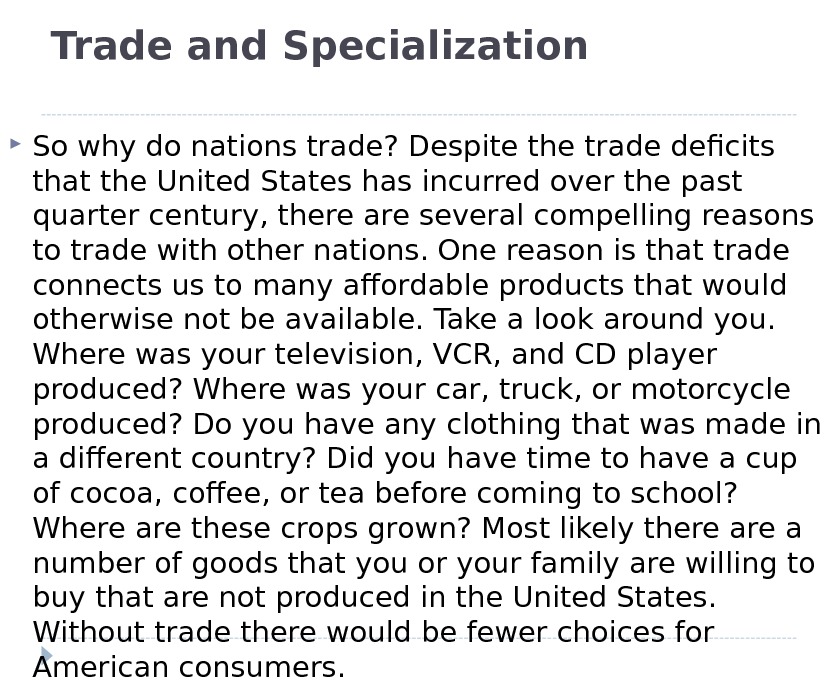
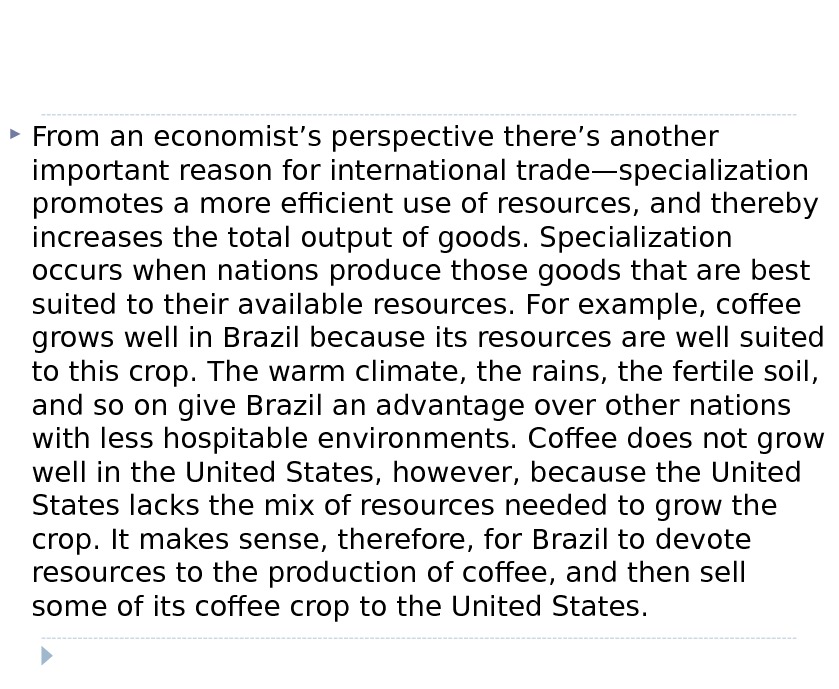
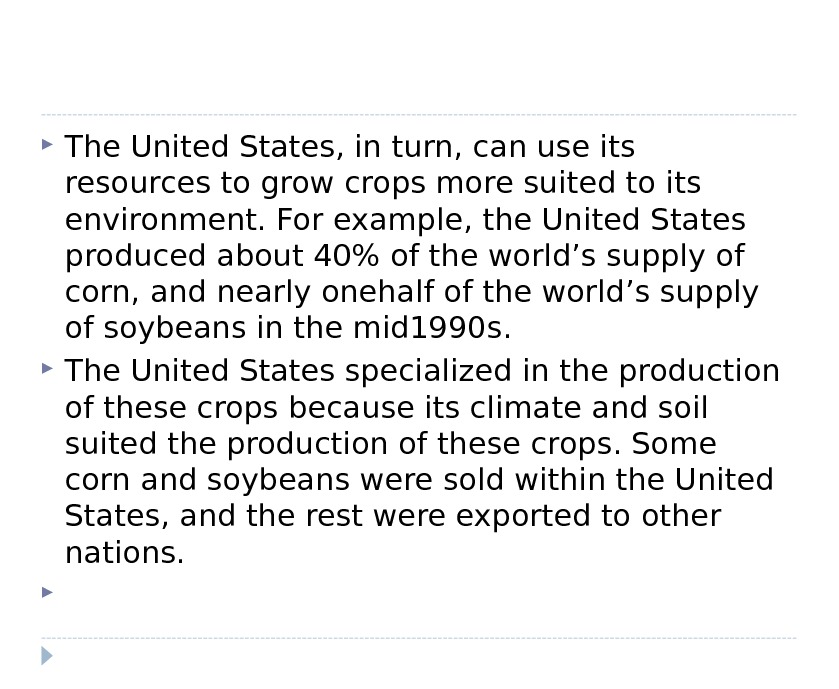
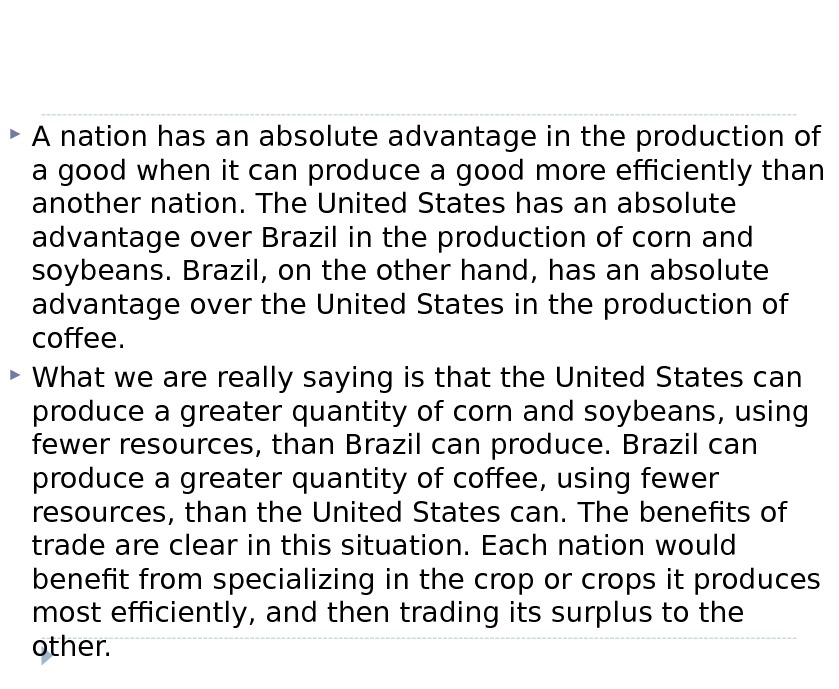
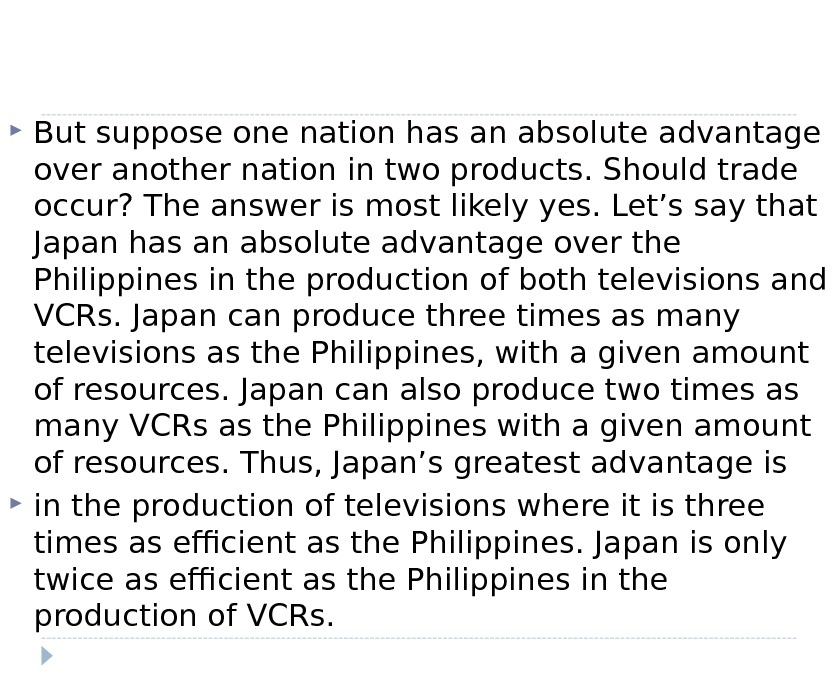
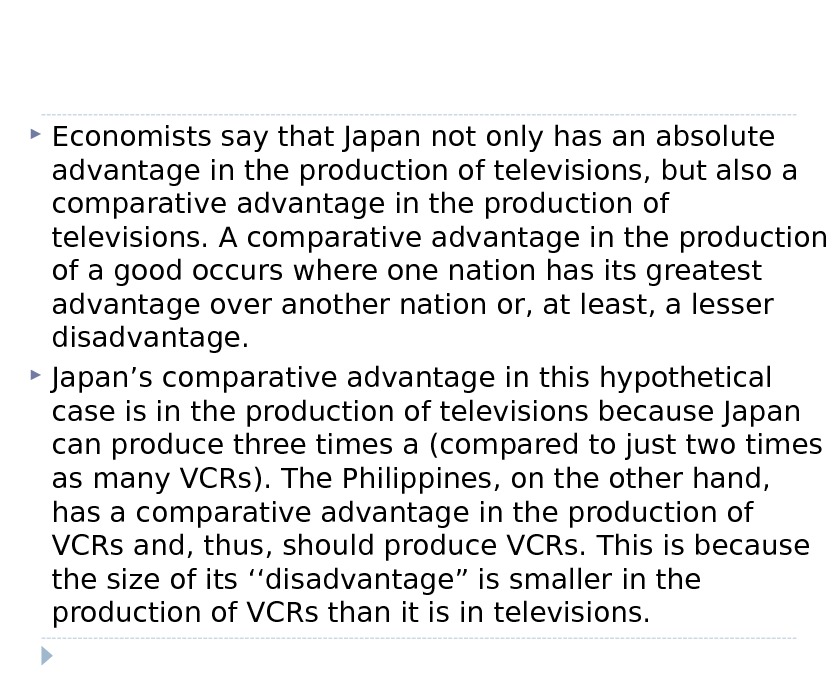
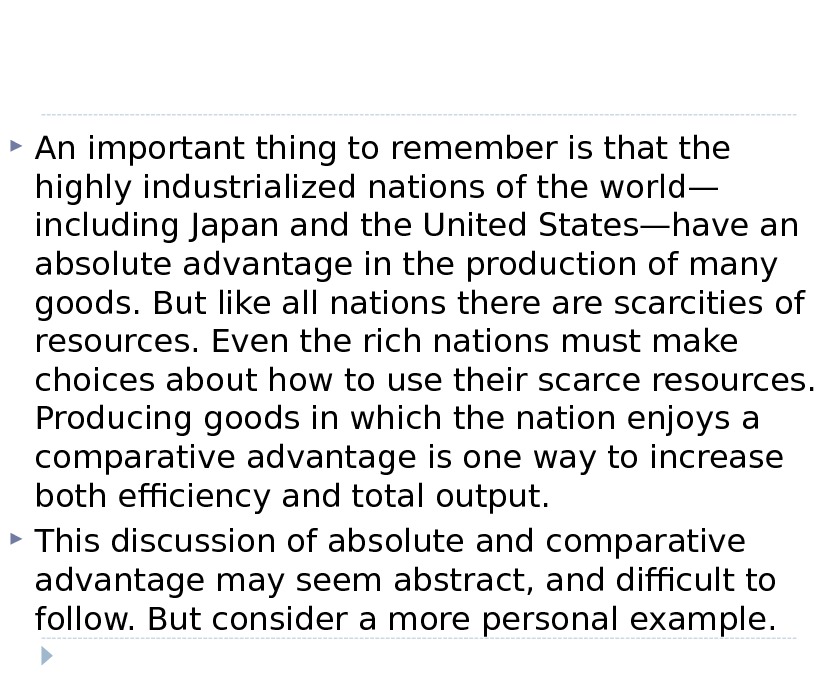

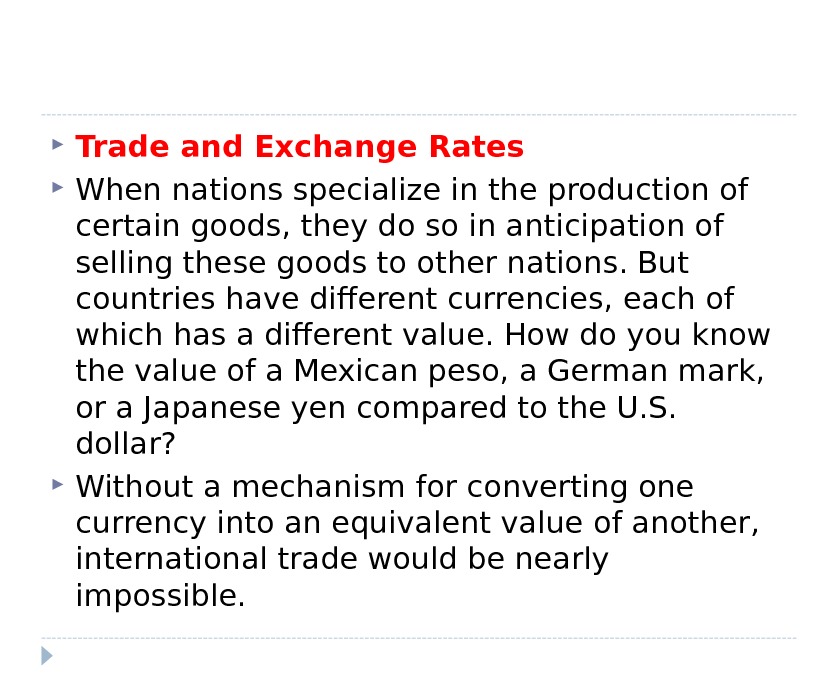
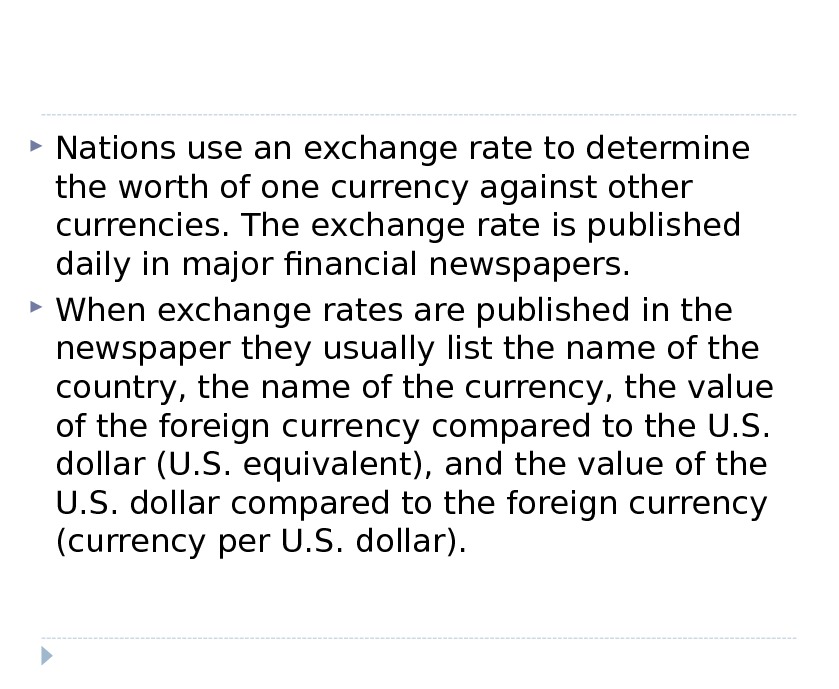
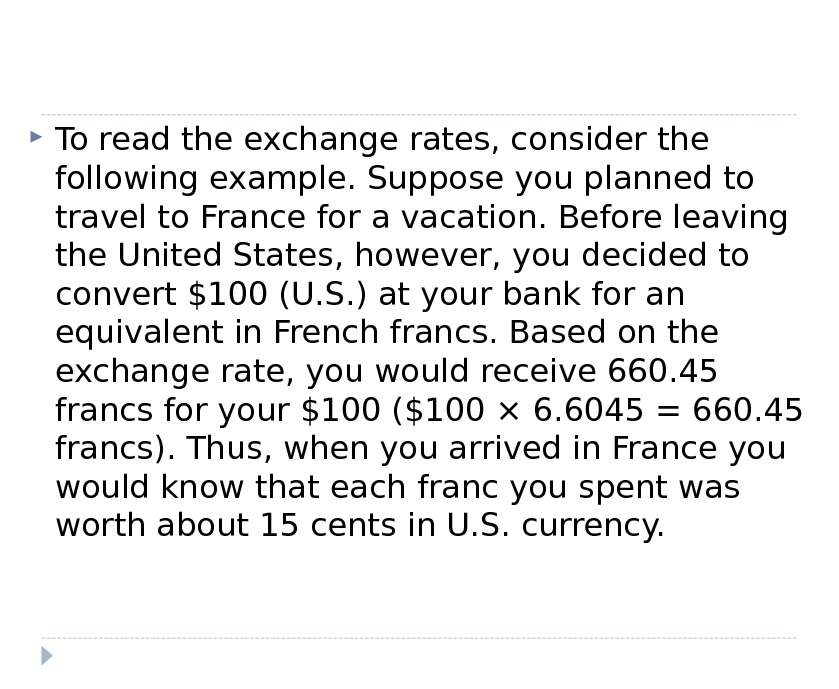
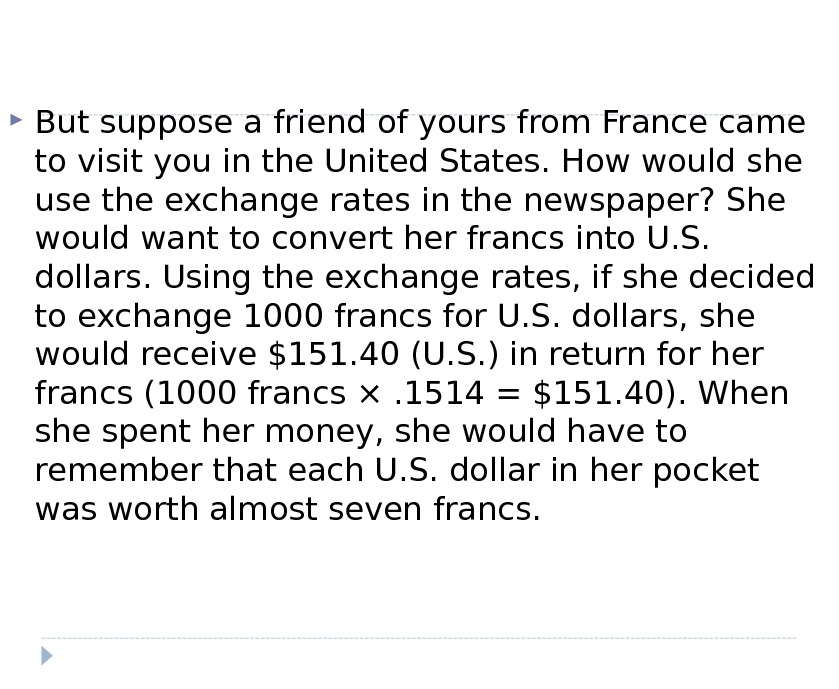
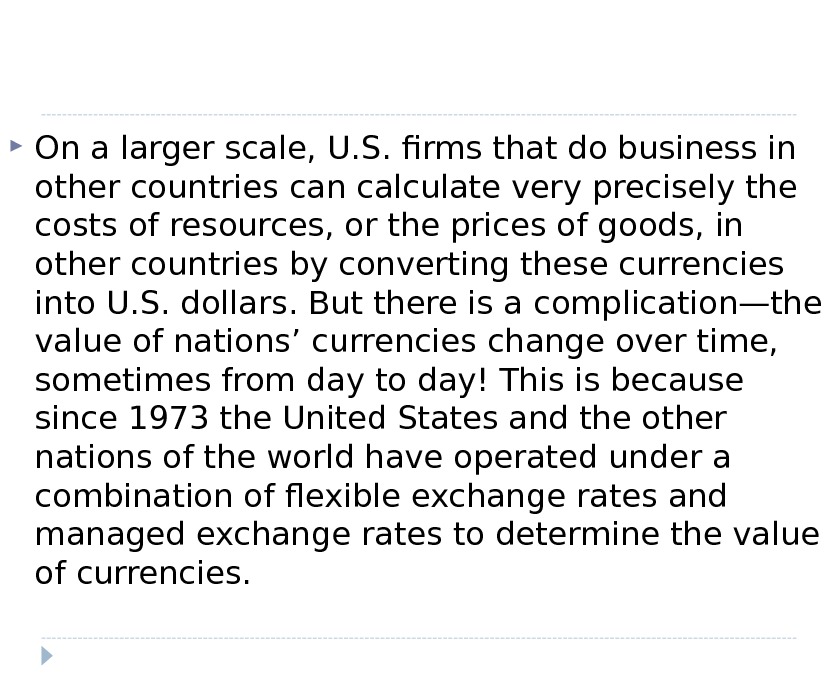
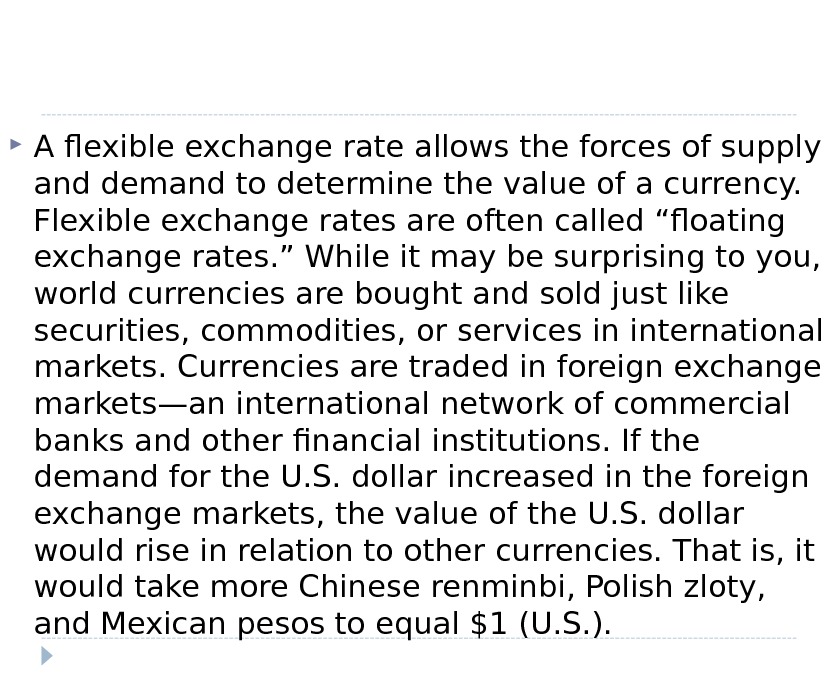
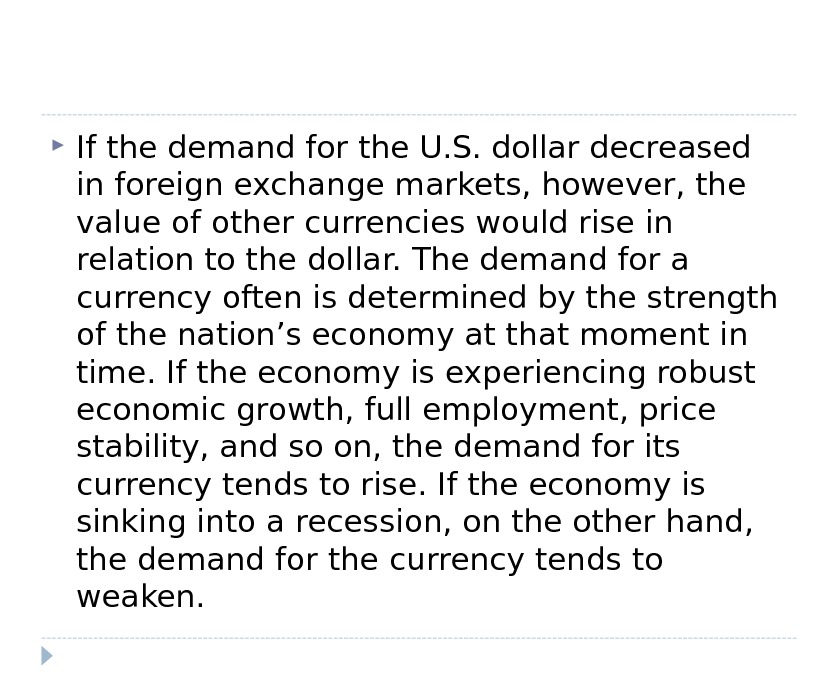
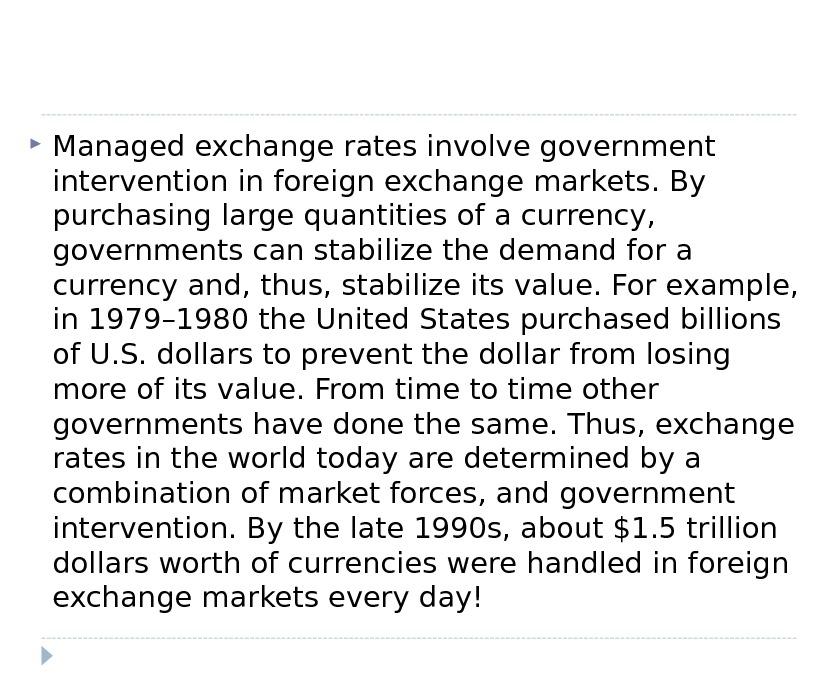
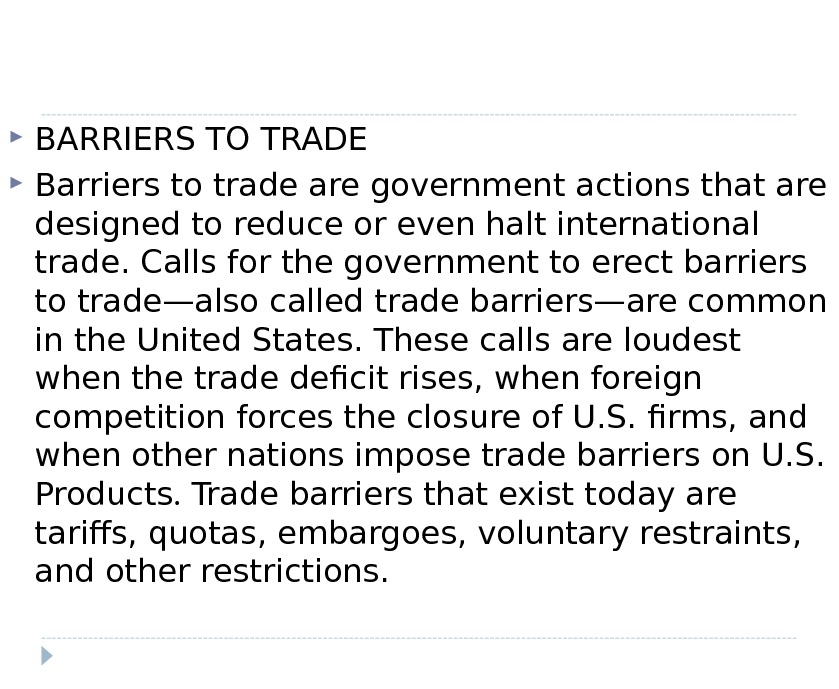
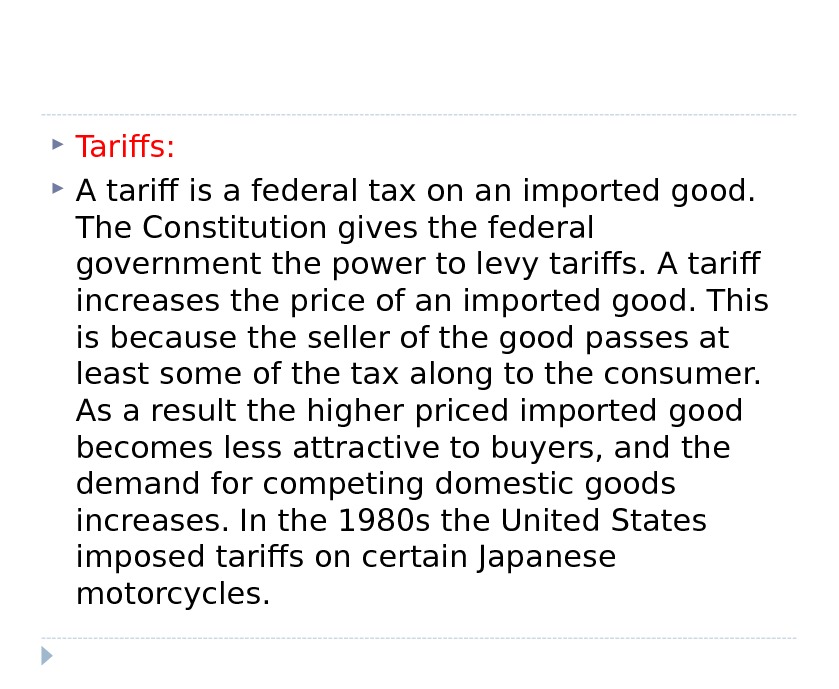
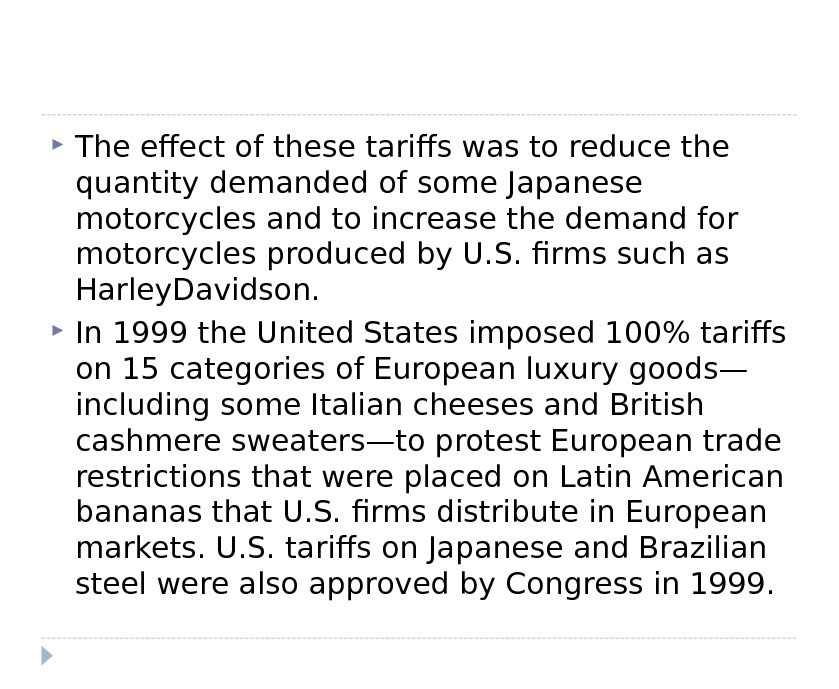
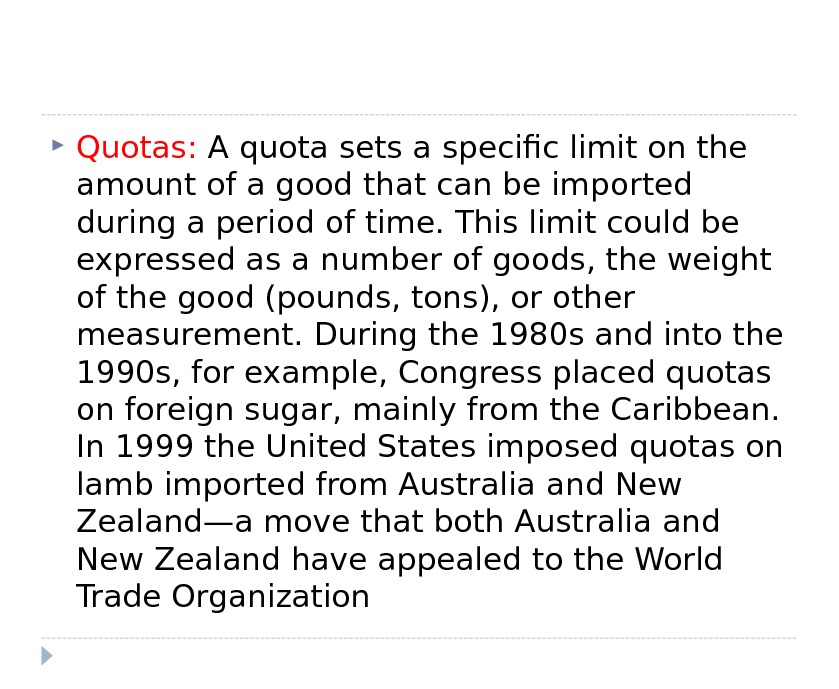
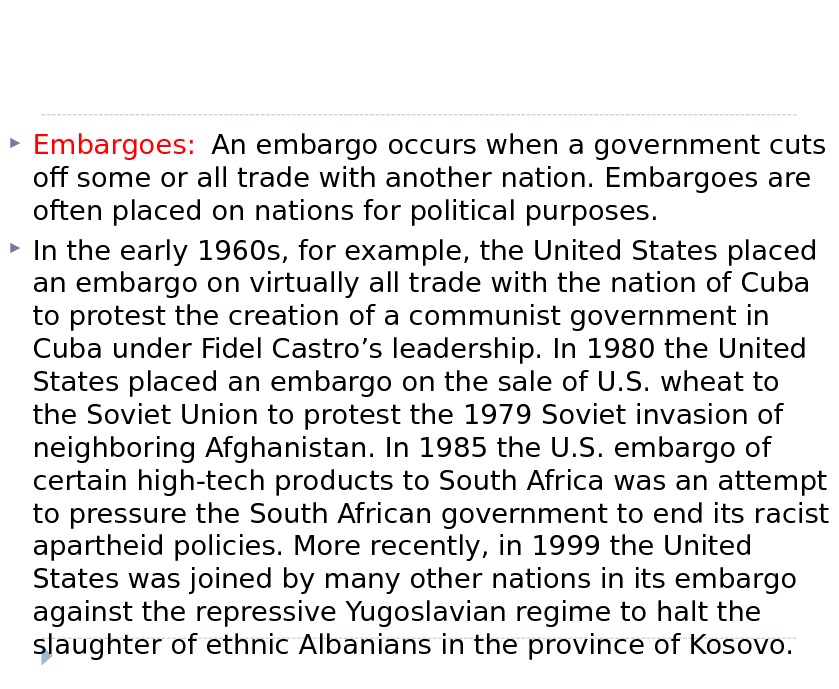
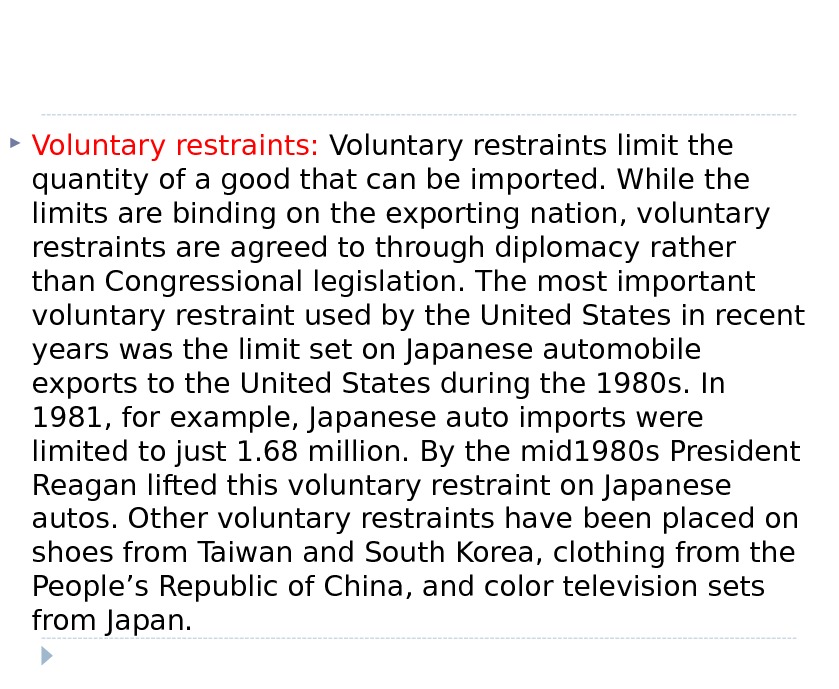
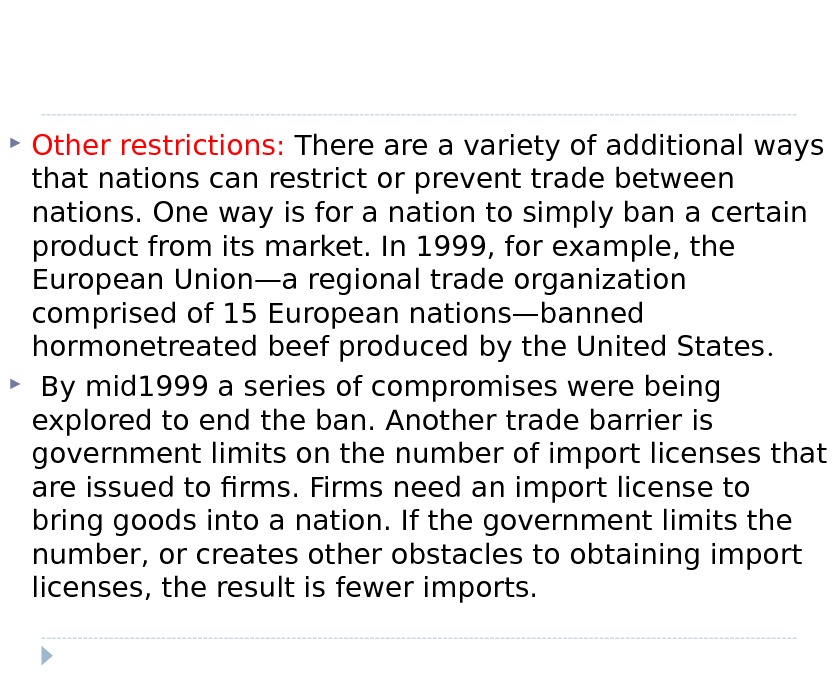
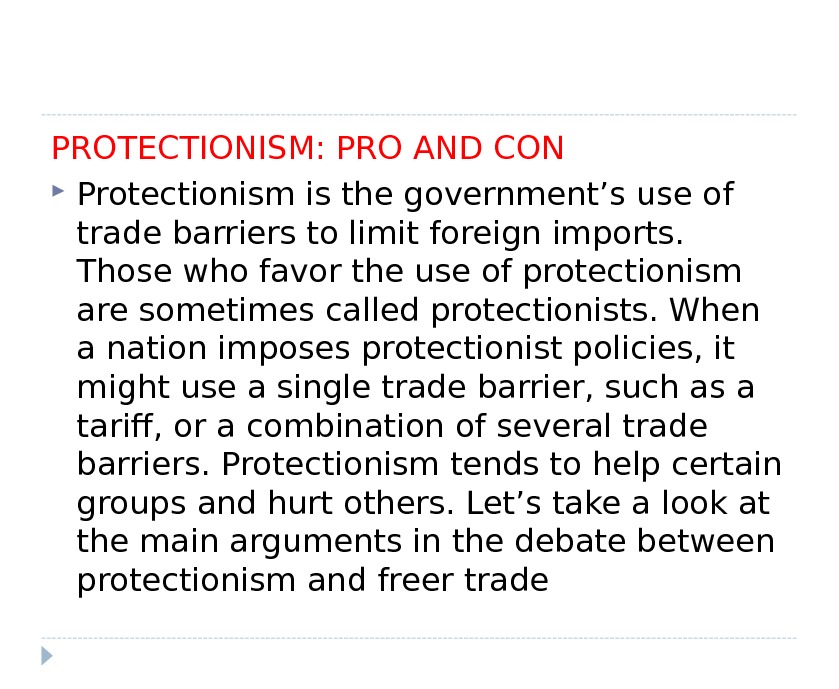
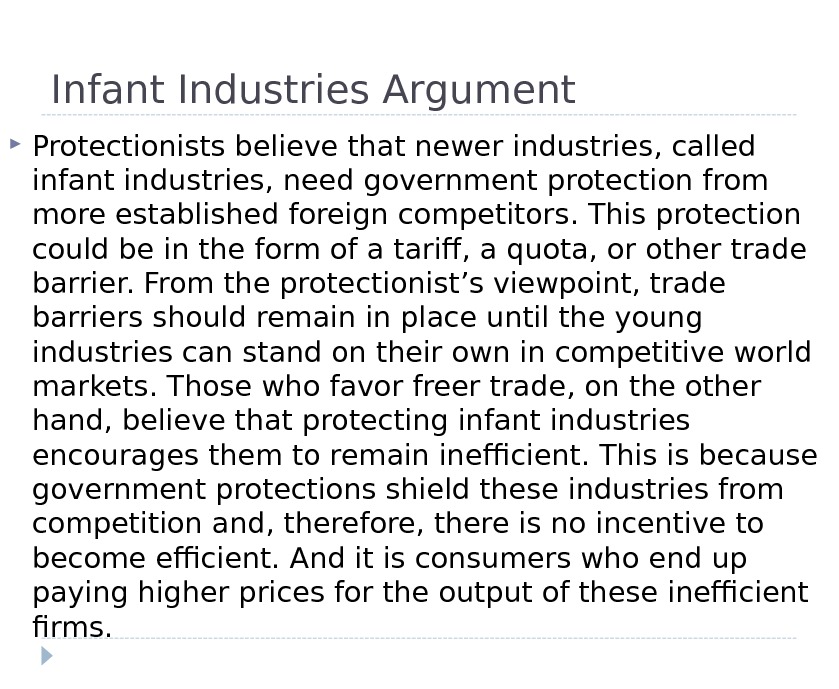
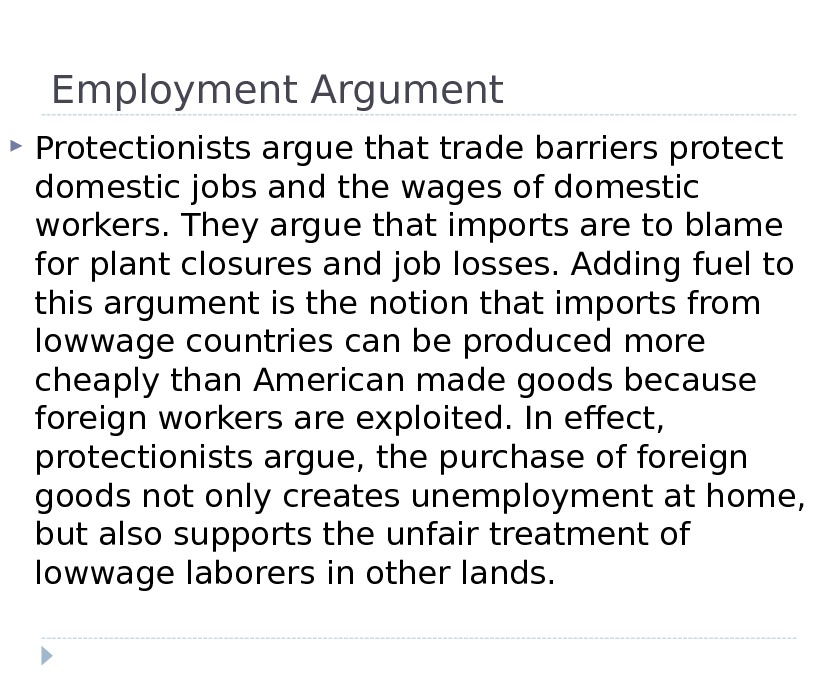
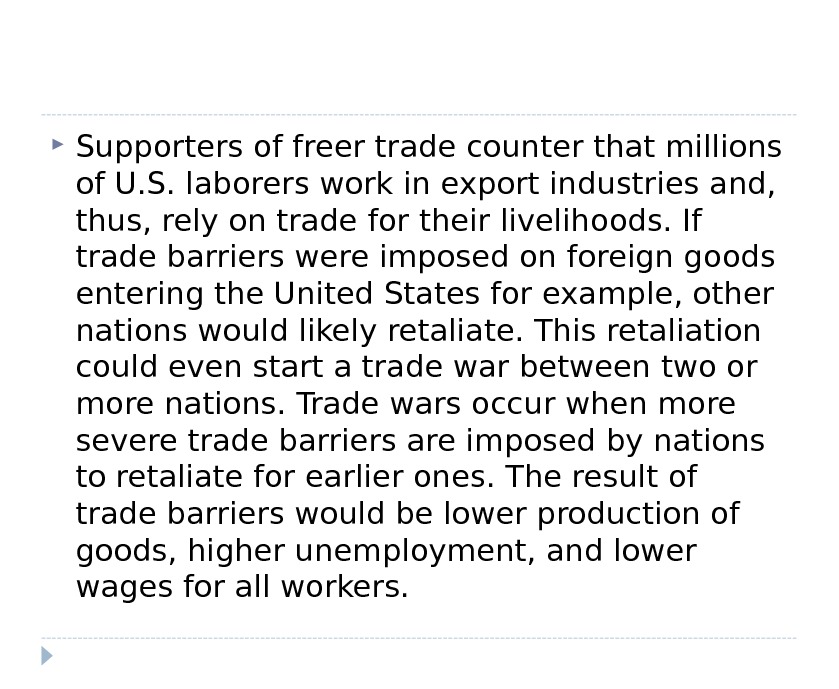

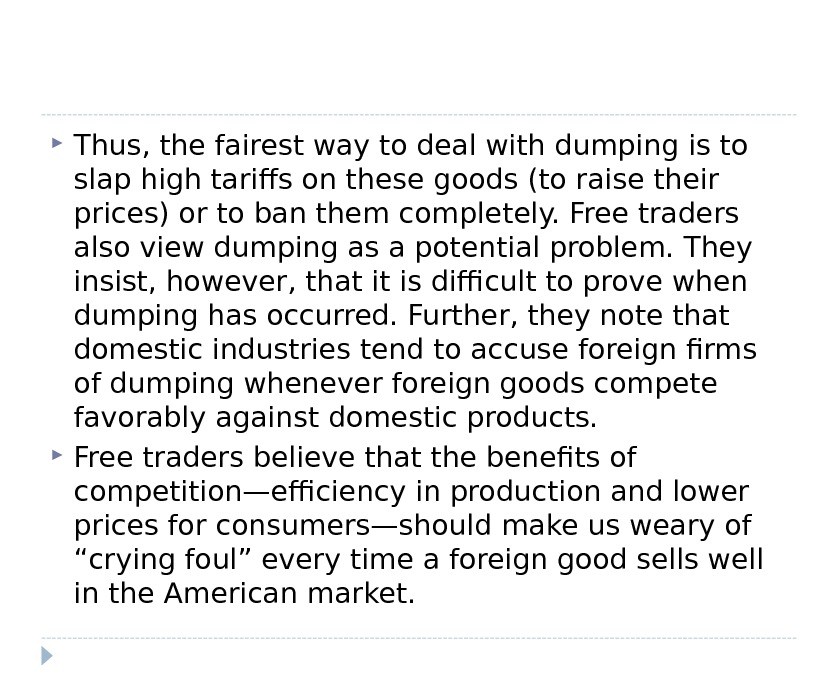
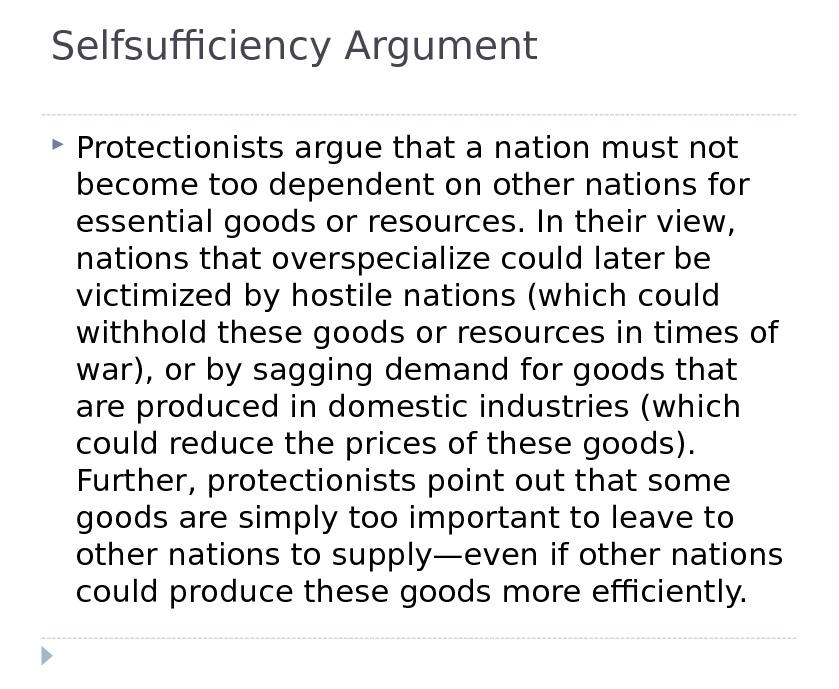
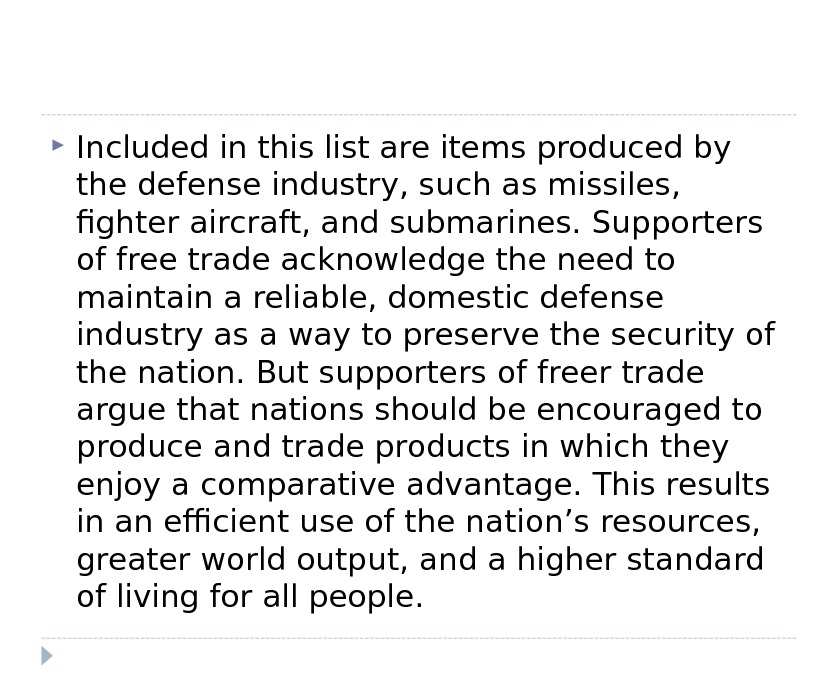

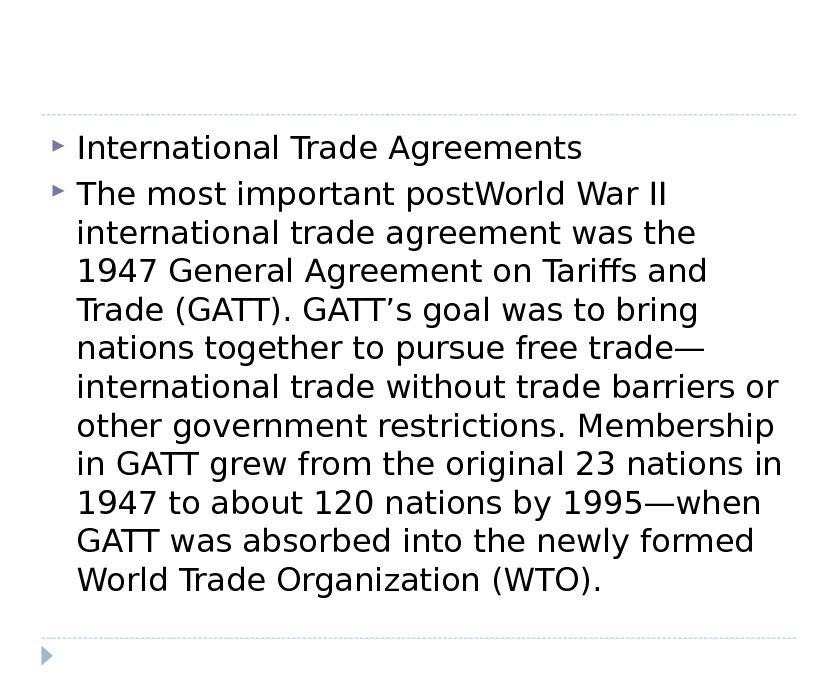
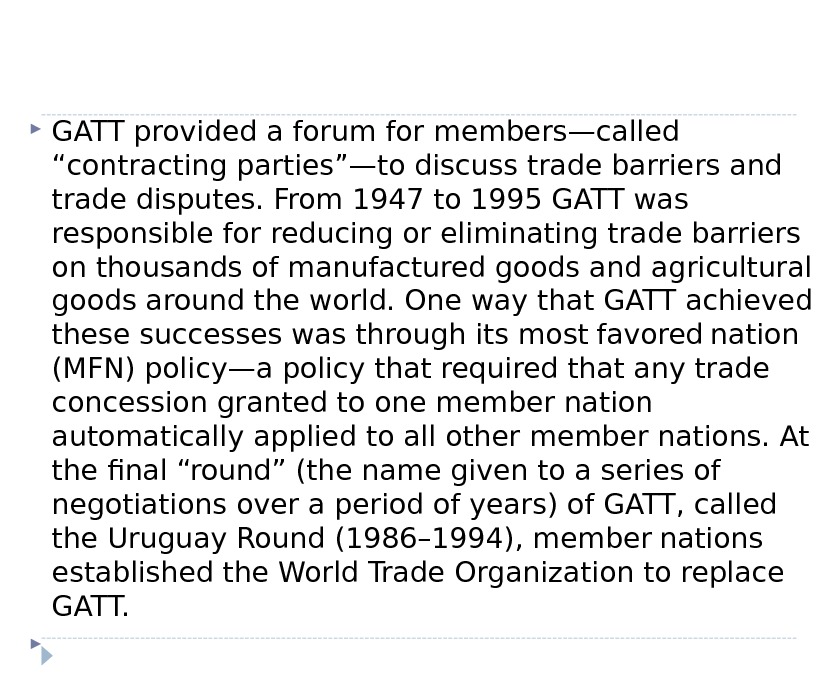
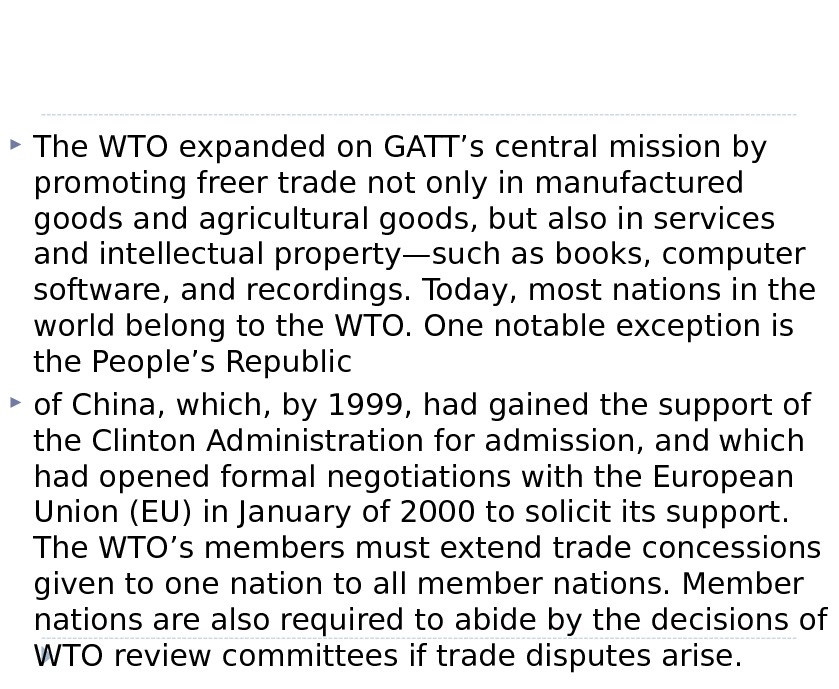
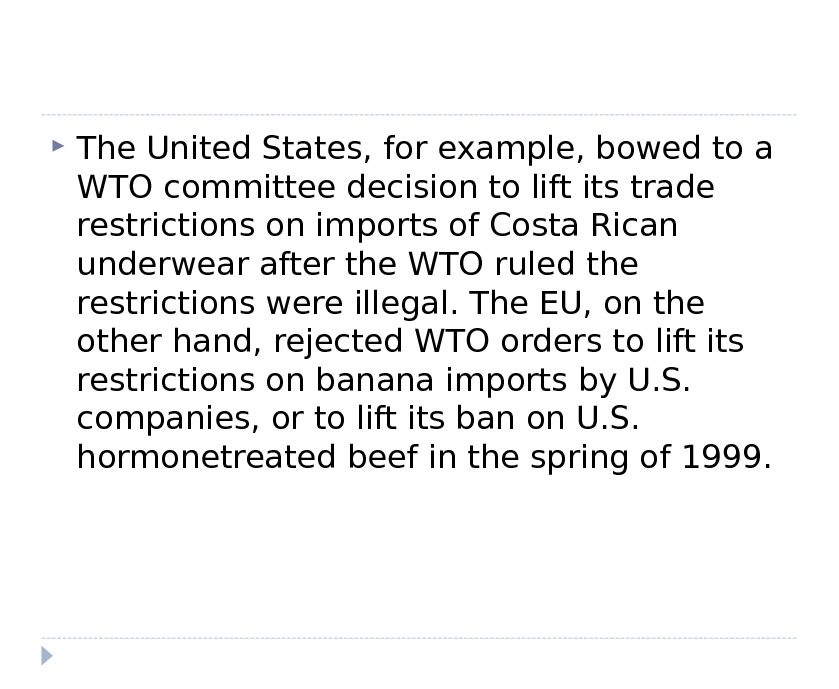

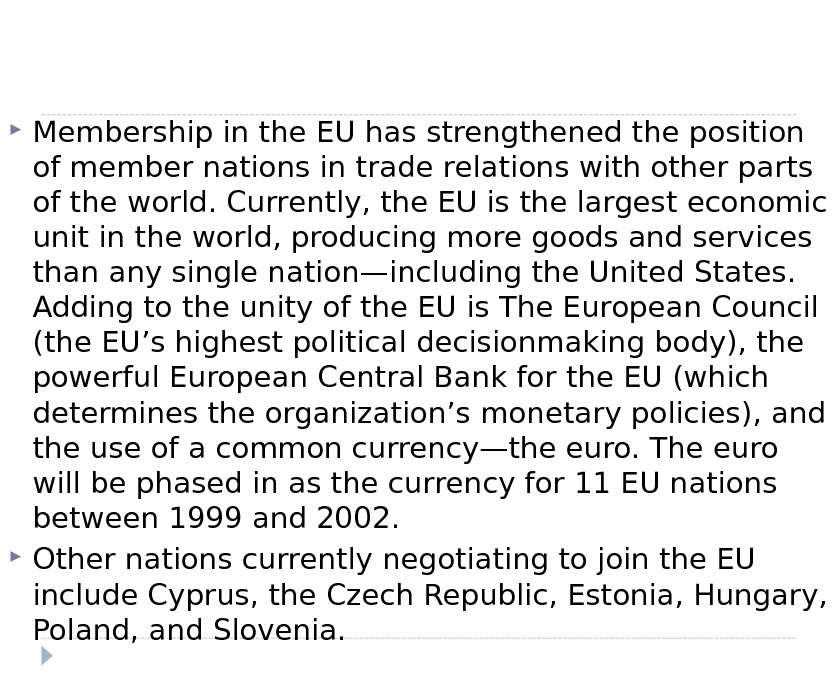
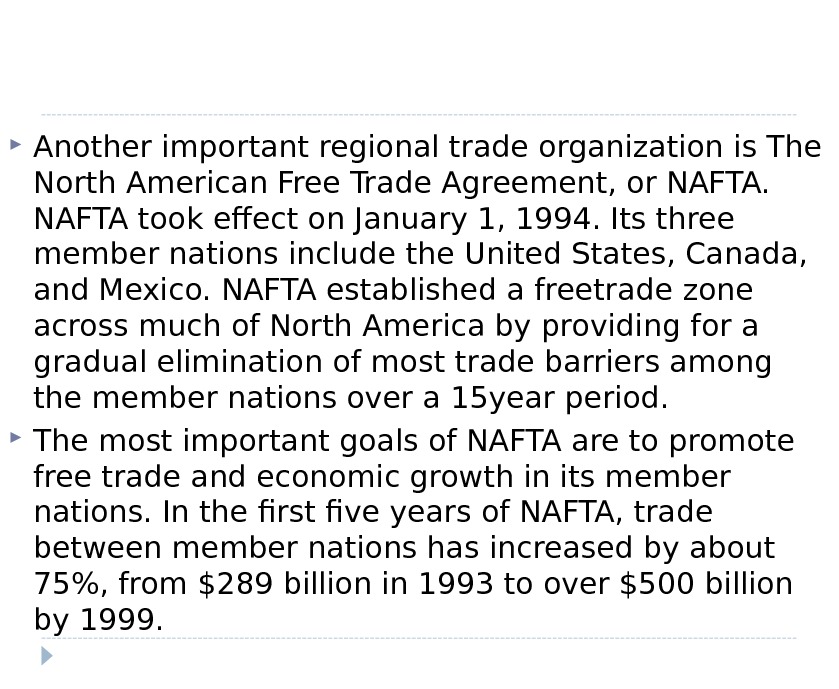

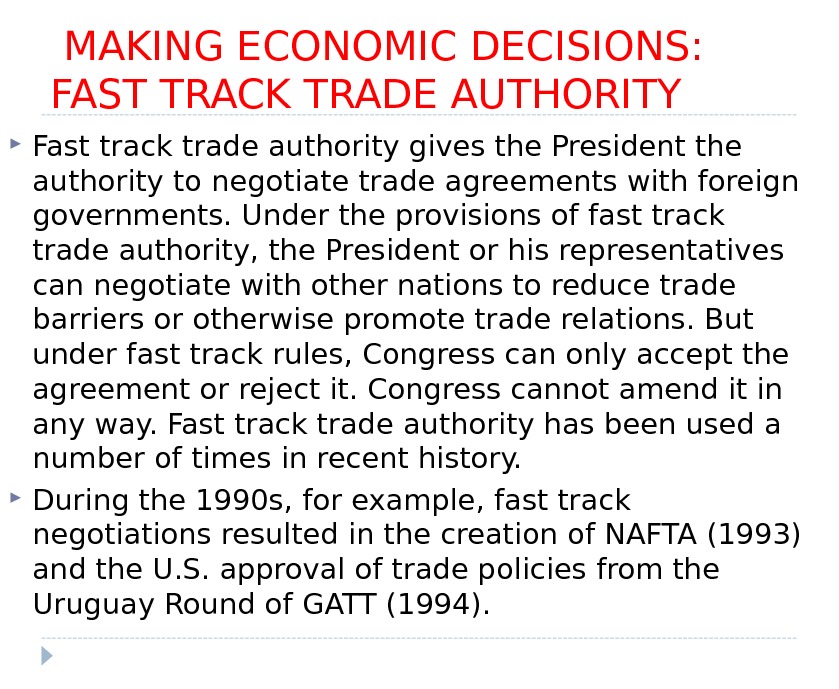
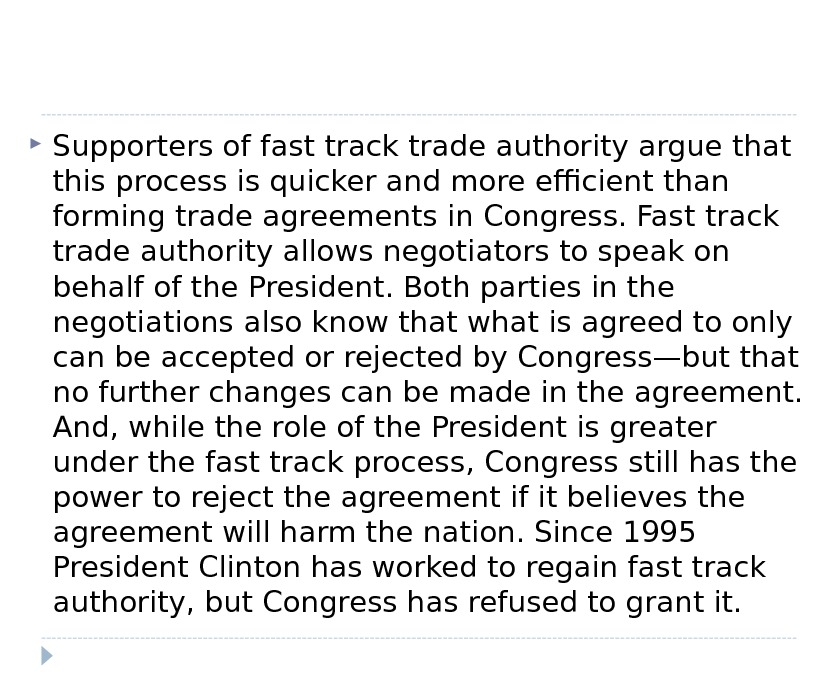
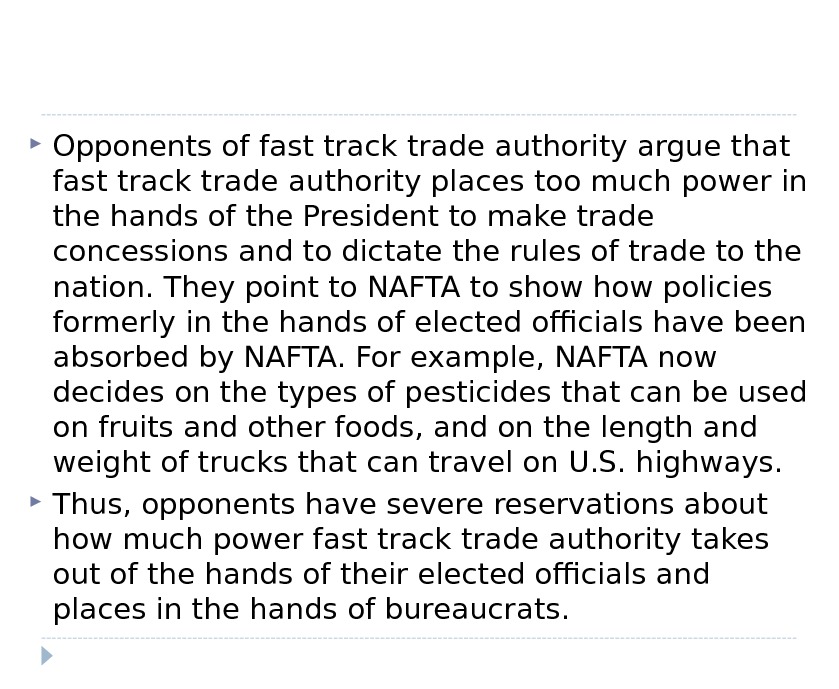

- Размер: 590 Кб
- Количество слайдов: 56
Описание презентации WHY DO NATIONS TRADE? GOALS OF CLASS по слайдам
 WHY DO NATIONS TRADE?
WHY DO NATIONS TRADE?
 GOALS OF CLASS This class examines international trade—why nations trade and why they sometimes place limits on trade. Trade benefits nations by allowing them to specialize in the production of goods and services that they produce most efficiently. They can then exchange these products for goods that have been efficiently produced by other nations. At times, nations restrict the free flow of goods and services across national borders by imposing barriers to trade, such as tariffs or quotas. Despite these barriers to trade, conscious efforts have been made to create freer trade in world markets since World War II. In the 1990 s the rise of regional trade associations has helped reduce trade barriers among participating nations. There is still considerable debate about what type of trade policy the United States should have, however. The record breaking U. S. trade deficits of the late 1990 s intensified the debate between those who favor freer trade and those who favor protectionism.
GOALS OF CLASS This class examines international trade—why nations trade and why they sometimes place limits on trade. Trade benefits nations by allowing them to specialize in the production of goods and services that they produce most efficiently. They can then exchange these products for goods that have been efficiently produced by other nations. At times, nations restrict the free flow of goods and services across national borders by imposing barriers to trade, such as tariffs or quotas. Despite these barriers to trade, conscious efforts have been made to create freer trade in world markets since World War II. In the 1990 s the rise of regional trade associations has helped reduce trade barriers among participating nations. There is still considerable debate about what type of trade policy the United States should have, however. The record breaking U. S. trade deficits of the late 1990 s intensified the debate between those who favor freer trade and those who favor protectionism.
 INTERNATIONAL TRADE: IMPORTING AND EXPORTING International trade occurs when individuals, firms, or governments import or export goods or services. Imports are the goods or services that are purchased from other nations. Exports are the goods or services that are sold to other nations. Imports and Exports According to the Bureau of the Census, the United States imported about $1, 030 billion worth of goods in 1999. What types of goods does the United States import? The largest single category of imports is capital goods, including different kinds of machinery and equipment (29%) , important imports include industrial supplies and materials (16, 6%), automobiles and auto parts (16%), and petroleum and related petroleum products (8, 2%) Other (30, 2%).
INTERNATIONAL TRADE: IMPORTING AND EXPORTING International trade occurs when individuals, firms, or governments import or export goods or services. Imports are the goods or services that are purchased from other nations. Exports are the goods or services that are sold to other nations. Imports and Exports According to the Bureau of the Census, the United States imported about $1, 030 billion worth of goods in 1999. What types of goods does the United States import? The largest single category of imports is capital goods, including different kinds of machinery and equipment (29%) , important imports include industrial supplies and materials (16, 6%), automobiles and auto parts (16%), and petroleum and related petroleum products (8, 2%) Other (30, 2%).
 Most of America’s imports come from the industrialized nations of the world. In 1998 the United States imported more goods from Canada than from any other nation ($173 billion). The United States also imported significant amounts of merchandise from other industrialized nations including Japan ($122 billion), Germany ($50 billion), UK ($35 billion), France ($24 billion), and Italy ($21 billion). During the 1990 s imports from the developing world also increased. By 1998, four of the top ten importers of goods to the United States were less developed nations including Mexico ($95 billion), China ($71 billion), Taiwan ($33 billion), and South Korea ($24 billion). These figures represent U. S. imports of goods, or merchandise, but do not include services.
Most of America’s imports come from the industrialized nations of the world. In 1998 the United States imported more goods from Canada than from any other nation ($173 billion). The United States also imported significant amounts of merchandise from other industrialized nations including Japan ($122 billion), Germany ($50 billion), UK ($35 billion), France ($24 billion), and Italy ($21 billion). During the 1990 s imports from the developing world also increased. By 1998, four of the top ten importers of goods to the United States were less developed nations including Mexico ($95 billion), China ($71 billion), Taiwan ($33 billion), and South Korea ($24 billion). These figures represent U. S. imports of goods, or merchandise, but do not include services.
 The Commerce Department also reported that the United States exported about $683 billion worth of goods in 1999. The most important category of U. S. merchandise exports in the 1990 s was capital goods (43, 5%). This is predictable because the United States is a highly industrialized nation capable of producing sophisticated machinery and equipment. Other important categories of exports included industrial supplies and materials (21, 7%), automobiles and parts(10, 9%), and agricultural products (including feed grains) (8, 6%), Other (15, 3%). In 1998 most of America’s exports were sold in the industrialized nations, including Canada ($157 billion), Japan ($58 billion), UK ($39 billion), Germany ($27 billion), Netherlands ($19 billion), and France ($18 billion). The largest buyer of U. S. exports in the developing world was Mexico ($79 billion).
The Commerce Department also reported that the United States exported about $683 billion worth of goods in 1999. The most important category of U. S. merchandise exports in the 1990 s was capital goods (43, 5%). This is predictable because the United States is a highly industrialized nation capable of producing sophisticated machinery and equipment. Other important categories of exports included industrial supplies and materials (21, 7%), automobiles and parts(10, 9%), and agricultural products (including feed grains) (8, 6%), Other (15, 3%). In 1998 most of America’s exports were sold in the industrialized nations, including Canada ($157 billion), Japan ($58 billion), UK ($39 billion), Germany ($27 billion), Netherlands ($19 billion), and France ($18 billion). The largest buyer of U. S. exports in the developing world was Mexico ($79 billion).
 Balance of Trade The balance of trade shows the relationship between the nation’s total merchandise imports and its merchandise exports in a given year. When the value of a nation’s imports are greater than the value of its exports, the nation has a merchandise trade deficit. This is because the nation is paying more money out to other nations to buy their goods than it is receiving from these nations. When a nation has a trade deficit, economists say that it has a “negative balance of trade. ”
Balance of Trade The balance of trade shows the relationship between the nation’s total merchandise imports and its merchandise exports in a given year. When the value of a nation’s imports are greater than the value of its exports, the nation has a merchandise trade deficit. This is because the nation is paying more money out to other nations to buy their goods than it is receiving from these nations. When a nation has a trade deficit, economists say that it has a “negative balance of trade. ”
 According to the Department of Commerce, in 1998 the United States had its largest trade deficits with Japan (− $64 billion), China (−$57 billion), Germany (−$23 billion), Canada (−$17 billion), and Mexico (−$16 billion). When, on the other hand, the value of a nation’s exports are greater in value than its imports, the nation has a merchandise trade surplus. This occurs because the nation is receiving more in money payments for its goods than it is paying out to other nations for their goods. Economists sometimes call a trade surplus a “positive balance of trade. ” The Department of Commerce also reported that in 1998 the United States recorded its largest trade surpluses with the Netherlands (+$11 billion), Australia (+$7 billion), Belgium and Luxembourg (+$6 billion), Brazil (+$5 billion), and Saudi Arabia (+$4 billion).
According to the Department of Commerce, in 1998 the United States had its largest trade deficits with Japan (− $64 billion), China (−$57 billion), Germany (−$23 billion), Canada (−$17 billion), and Mexico (−$16 billion). When, on the other hand, the value of a nation’s exports are greater in value than its imports, the nation has a merchandise trade surplus. This occurs because the nation is receiving more in money payments for its goods than it is paying out to other nations for their goods. Economists sometimes call a trade surplus a “positive balance of trade. ” The Department of Commerce also reported that in 1998 the United States recorded its largest trade surpluses with the Netherlands (+$11 billion), Australia (+$7 billion), Belgium and Luxembourg (+$6 billion), Brazil (+$5 billion), and Saudi Arabia (+$4 billion).
 The United States has experienced merchandise trade deficits every year since 1975. These trade deficits have been increasing since the 1970 s, and by 1999 the trade deficit hit a staggering $347 billion ($1, 030 in imports and $68. 3 billion in exports). The average merchandise trade deficit in the 1970 s was about $10 billion per year, in the 1980 s was $94 billion, and in the 1990 s had grown to $173 billion per year.
The United States has experienced merchandise trade deficits every year since 1975. These trade deficits have been increasing since the 1970 s, and by 1999 the trade deficit hit a staggering $347 billion ($1, 030 in imports and $68. 3 billion in exports). The average merchandise trade deficit in the 1970 s was about $10 billion per year, in the 1980 s was $94 billion, and in the 1990 s had grown to $173 billion per year.
 There are many reasons for the U. S. trade deficits since the 1970 s. One reason has been the soaring prices of some important imports, such as oil. During the late 1970 s and early 1980 s, for example, imported petroleum and related products regularly accounted for more than a quarter of all U. S. imports—close to one third of all imported goods in 1980—compared to under 10% by the late 1990 s. The strength of the OPEC oil cartel was a major reason for the dramatic increase in world oil prices. Another reason for U. S. trade deficits has been the success of foreign products in key U. S. markets. Automobiles, for example, accounted for less than 5% of U. S. imports in 1965, or about $1 billion. By 1997 autos accounted for 16% of all U. S. imports, or a staggering $141 billion.
There are many reasons for the U. S. trade deficits since the 1970 s. One reason has been the soaring prices of some important imports, such as oil. During the late 1970 s and early 1980 s, for example, imported petroleum and related products regularly accounted for more than a quarter of all U. S. imports—close to one third of all imported goods in 1980—compared to under 10% by the late 1990 s. The strength of the OPEC oil cartel was a major reason for the dramatic increase in world oil prices. Another reason for U. S. trade deficits has been the success of foreign products in key U. S. markets. Automobiles, for example, accounted for less than 5% of U. S. imports in 1965, or about $1 billion. By 1997 autos accounted for 16% of all U. S. imports, or a staggering $141 billion.
 Other foreign products have also made significant gains in U. S. markets including electronic equipment, textiles, and motorcycles. A third reason for U. S. trade deficits has been the overall strength of the U. S. economy compared to other economies in the world. The U. S. expansion of the 1990 s—the longest since World War II—has increased the confidence of the American consumer. This confidence, in turn, has increased the demand for consumer goods, both foreign and domestic. Some other economies have not been so fortunate. Japan’s recession deepened by the late 1990 s, and many of the economies in Asia experienced downturns about the same time. What does this mean for American exporters? It means that fewer U. S. goods will sell abroad because both money and confidence are in short supply.
Other foreign products have also made significant gains in U. S. markets including electronic equipment, textiles, and motorcycles. A third reason for U. S. trade deficits has been the overall strength of the U. S. economy compared to other economies in the world. The U. S. expansion of the 1990 s—the longest since World War II—has increased the confidence of the American consumer. This confidence, in turn, has increased the demand for consumer goods, both foreign and domestic. Some other economies have not been so fortunate. Japan’s recession deepened by the late 1990 s, and many of the economies in Asia experienced downturns about the same time. What does this mean for American exporters? It means that fewer U. S. goods will sell abroad because both money and confidence are in short supply.
 Trade in Services In addition to trade in merchandise, nations also conduct trade in services. The United States has experienced a trade surplus in services in most years since World War II. A trade surplus in services occurs when the value of services exported from a nation is greater than the value of services imported by the nation. During the 1990 s the United States enjoyed an average trade surplus in services of about $67 billion per year. Included are financial services such as banking and insurance, telecommunications, tourism, and so on. U. S. trade surpluses for the 1990 s are shown in Figure
Trade in Services In addition to trade in merchandise, nations also conduct trade in services. The United States has experienced a trade surplus in services in most years since World War II. A trade surplus in services occurs when the value of services exported from a nation is greater than the value of services imported by the nation. During the 1990 s the United States enjoyed an average trade surplus in services of about $67 billion per year. Included are financial services such as banking and insurance, telecommunications, tourism, and so on. U. S. trade surpluses for the 1990 s are shown in Figure
 U. S. Trade in Goods and Services, 1990– 1999 (in billions)Year Merchandise Trade Balance Services Trade Balance in Goods and Services 1990 −$109 +$28 −$81 1991 −$74 +$43 −$31 1992 −$96 +$59 −$37 1993 −$133 +$63 −$70 1994 −$166 +$68 −$98 1995 −$174 +$76 −$98 1996 −$191 +$87 −$104 1997 −$197 +$92 −$105 1998 −$247 +$83 −$164 1999 −$347 +$76 −$
U. S. Trade in Goods and Services, 1990– 1999 (in billions)Year Merchandise Trade Balance Services Trade Balance in Goods and Services 1990 −$109 +$28 −$81 1991 −$74 +$43 −$31 1992 −$96 +$59 −$37 1993 −$133 +$63 −$70 1994 −$166 +$68 −$98 1995 −$174 +$76 −$98 1996 −$191 +$87 −$104 1997 −$197 +$92 −$105 1998 −$247 +$83 −$164 1999 −$347 +$76 −$
 Trade and Specialization So why do nations trade? Despite the trade deficits that the United States has incurred over the past quarter century, there are several compelling reasons to trade with other nations. One reason is that trade connects us to many affordable products that would otherwise not be available. Take a look around you. Where was your television, VCR, and CD player produced? Where was your car, truck, or motorcycle produced? Do you have any clothing that was made in a different country? Did you have time to have a cup of cocoa, coffee, or tea before coming to school? Where are these crops grown? Most likely there a number of goods that you or your family are willing to buy that are not produced in the United States. Without trade there would be fewer choices for American consumers.
Trade and Specialization So why do nations trade? Despite the trade deficits that the United States has incurred over the past quarter century, there are several compelling reasons to trade with other nations. One reason is that trade connects us to many affordable products that would otherwise not be available. Take a look around you. Where was your television, VCR, and CD player produced? Where was your car, truck, or motorcycle produced? Do you have any clothing that was made in a different country? Did you have time to have a cup of cocoa, coffee, or tea before coming to school? Where are these crops grown? Most likely there a number of goods that you or your family are willing to buy that are not produced in the United States. Without trade there would be fewer choices for American consumers.
 From an economist’s perspective there’s another important reason for international trade—specialization promotes a more efficient use of resources, and thereby increases the total output of goods. Specialization occurs when nations produce those goods that are best suited to their available resources. For example, coffee grows well in Brazil because its resources are well suited to this crop. The warm climate, the rains, the fertile soil, and so on give Brazil an advantage over other nations with less hospitable environments. Coffee does not grow well in the United States, however, because the United States lacks the mix of resources needed to grow the crop. It makes sense, therefore, for Brazil to devote resources to the production of coffee, and then sell some of its coffee crop to the United States.
From an economist’s perspective there’s another important reason for international trade—specialization promotes a more efficient use of resources, and thereby increases the total output of goods. Specialization occurs when nations produce those goods that are best suited to their available resources. For example, coffee grows well in Brazil because its resources are well suited to this crop. The warm climate, the rains, the fertile soil, and so on give Brazil an advantage over other nations with less hospitable environments. Coffee does not grow well in the United States, however, because the United States lacks the mix of resources needed to grow the crop. It makes sense, therefore, for Brazil to devote resources to the production of coffee, and then sell some of its coffee crop to the United States.
 The United States, in turn, can use its resources to grow crops more suited to its environment. For example, the United States produced about 40% of the world’s supply of corn, and nearly onehalf of the world’s supply of soybeans in the mid 1990 s. The United States specialized in the production of these crops because its climate and soil suited the production of these crops. Some corn and soybeans were sold within the United States, and the rest were exported to other nations.
The United States, in turn, can use its resources to grow crops more suited to its environment. For example, the United States produced about 40% of the world’s supply of corn, and nearly onehalf of the world’s supply of soybeans in the mid 1990 s. The United States specialized in the production of these crops because its climate and soil suited the production of these crops. Some corn and soybeans were sold within the United States, and the rest were exported to other nations.
 A nation has an absolute advantage in the production of a good when it can produce a good more efficiently than another nation. The United States has an absolute advantage over Brazil in the production of corn and soybeans. Brazil, on the other hand, has an absolute advantage over the United States in the production of coffee. What we are really saying is that the United States can produce a greater quantity of corn and soybeans, using fewer resources, than Brazil can produce a greater quantity of coffee, using fewer resources, than the United States can. The benefits of trade are clear in this situation. Each nation would benefit from specializing in the crop or crops it produces most efficiently, and then trading its surplus to the other.
A nation has an absolute advantage in the production of a good when it can produce a good more efficiently than another nation. The United States has an absolute advantage over Brazil in the production of corn and soybeans. Brazil, on the other hand, has an absolute advantage over the United States in the production of coffee. What we are really saying is that the United States can produce a greater quantity of corn and soybeans, using fewer resources, than Brazil can produce a greater quantity of coffee, using fewer resources, than the United States can. The benefits of trade are clear in this situation. Each nation would benefit from specializing in the crop or crops it produces most efficiently, and then trading its surplus to the other.
 But suppose one nation has an absolute advantage over another nation in two products. Should trade occur? The answer is most likely yes. Let’s say that Japan has an absolute advantage over the Philippines in the production of both televisions and VCRs. Japan can produce three times as many televisions as the Philippines, with a given amount of resources. Japan can also produce two times as many VCRs as the Philippines with a given amount of resources. Thus, Japan’s greatest advantage is in the production of televisions where it is three times as efficient as the Philippines. Japan is only twice as efficient as the Philippines in the production of VCRs.
But suppose one nation has an absolute advantage over another nation in two products. Should trade occur? The answer is most likely yes. Let’s say that Japan has an absolute advantage over the Philippines in the production of both televisions and VCRs. Japan can produce three times as many televisions as the Philippines, with a given amount of resources. Japan can also produce two times as many VCRs as the Philippines with a given amount of resources. Thus, Japan’s greatest advantage is in the production of televisions where it is three times as efficient as the Philippines. Japan is only twice as efficient as the Philippines in the production of VCRs.
 Economists say that Japan not only has an absolute advantage in the production of televisions, but also a comparative advantage in the production of televisions. A comparative advantage in the production of a good occurs where one nation has its greatest advantage over another nation or, at least, a lesser disadvantage. Japan’s comparative advantage in this hypothetical case is in the production of televisions because Japan can produce three times a (compared to just two times as many VCRs). The Philippines, on the other hand, has a comparative advantage in the production of VCRs and, thus, should produce VCRs. This is because the size of its ‘‘disadvantage” is smaller in the production of VCRs than it is in televisions.
Economists say that Japan not only has an absolute advantage in the production of televisions, but also a comparative advantage in the production of televisions. A comparative advantage in the production of a good occurs where one nation has its greatest advantage over another nation or, at least, a lesser disadvantage. Japan’s comparative advantage in this hypothetical case is in the production of televisions because Japan can produce three times a (compared to just two times as many VCRs). The Philippines, on the other hand, has a comparative advantage in the production of VCRs and, thus, should produce VCRs. This is because the size of its ‘‘disadvantage” is smaller in the production of VCRs than it is in televisions.
 An important thing to remember is that the highly industrialized nations of the world— including Japan and the United States—have an absolute advantage in the production of many goods. But like all nations there are scarcities of resources. Even the rich nations must make choices about how to use their scarce resources. Producing goods in which the nation enjoys a comparative advantage is one way to increase both efficiency and total output. This discussion of absolute and comparative advantage may seem abstract, and difficult to follow. But consider a more personal example.
An important thing to remember is that the highly industrialized nations of the world— including Japan and the United States—have an absolute advantage in the production of many goods. But like all nations there are scarcities of resources. Even the rich nations must make choices about how to use their scarce resources. Producing goods in which the nation enjoys a comparative advantage is one way to increase both efficiency and total output. This discussion of absolute and comparative advantage may seem abstract, and difficult to follow. But consider a more personal example.
 Suppose you have an excellent history teacher at school. And suppose that this history teacher can also cook better than the person in charge of food services at your school. In economic terms, this history teacher has an absolute advantage over the food services person in both teaching and cooking. But the history teacher’s time—a resource—is scarce. He cannot cook and teach at the same time. The teacher may be twice as good a cook as the food services person, but ten times as good a teacher as the food services person. How should the teacher use his time? While you will miss some tasty lunches in the cafeteria, the teacher should specialize in that area in which he has the greatest advantage—teaching!
Suppose you have an excellent history teacher at school. And suppose that this history teacher can also cook better than the person in charge of food services at your school. In economic terms, this history teacher has an absolute advantage over the food services person in both teaching and cooking. But the history teacher’s time—a resource—is scarce. He cannot cook and teach at the same time. The teacher may be twice as good a cook as the food services person, but ten times as good a teacher as the food services person. How should the teacher use his time? While you will miss some tasty lunches in the cafeteria, the teacher should specialize in that area in which he has the greatest advantage—teaching!
 Trade and Exchange Rates When nations specialize in the production of certain goods, they do so in anticipation of selling these goods to other nations. But countries have different currencies, each of which has a different value. How do you know the value of a Mexican peso, a German mark, or a Japanese yen compared to the U. S. dollar? Without a mechanism for converting one currency into an equivalent value of another, international trade would be nearly impossible.
Trade and Exchange Rates When nations specialize in the production of certain goods, they do so in anticipation of selling these goods to other nations. But countries have different currencies, each of which has a different value. How do you know the value of a Mexican peso, a German mark, or a Japanese yen compared to the U. S. dollar? Without a mechanism for converting one currency into an equivalent value of another, international trade would be nearly impossible.
 Nations use an exchange rate to determine the worth of one currency against other currencies. The exchange rate is published daily in major financial newspapers. When exchange rates are published in the newspaper they usually list the name of the country, the name of the currency, the value of the foreign currency compared to the U. S. dollar (U. S. equivalent), and the value of the U. S. dollar compared to the foreign currency (currency per U. S. dollar).
Nations use an exchange rate to determine the worth of one currency against other currencies. The exchange rate is published daily in major financial newspapers. When exchange rates are published in the newspaper they usually list the name of the country, the name of the currency, the value of the foreign currency compared to the U. S. dollar (U. S. equivalent), and the value of the U. S. dollar compared to the foreign currency (currency per U. S. dollar).
 To read the exchange rates, consider the following example. Suppose you planned to travel to France for a vacation. Before leaving the United States, however, you decided to convert $100 (U. S. ) at your bank for an equivalent in French francs. Based on the exchange rate, you would receive 660. 45 francs for your $100 ($100 × 6. 6045 = 660. 45 francs). Thus, when you arrived in France you would know that each franc you spent was worth about 15 cents in U. S. currency.
To read the exchange rates, consider the following example. Suppose you planned to travel to France for a vacation. Before leaving the United States, however, you decided to convert $100 (U. S. ) at your bank for an equivalent in French francs. Based on the exchange rate, you would receive 660. 45 francs for your $100 ($100 × 6. 6045 = 660. 45 francs). Thus, when you arrived in France you would know that each franc you spent was worth about 15 cents in U. S. currency.
 But suppose a friend of yours from France came to visit you in the United States. How would she use the exchange rates in the newspaper? She would want to convert her francs into U. S. dollars. Using the exchange rates, if she decided to exchange 1000 francs for U. S. dollars, she would receive $151. 40 (U. S. ) in return for her francs (1000 francs ×. 1514 = $151. 40). When she spent her money, she would have to remember that each U. S. dollar in her pocket was worth almost seven francs.
But suppose a friend of yours from France came to visit you in the United States. How would she use the exchange rates in the newspaper? She would want to convert her francs into U. S. dollars. Using the exchange rates, if she decided to exchange 1000 francs for U. S. dollars, she would receive $151. 40 (U. S. ) in return for her francs (1000 francs ×. 1514 = $151. 40). When she spent her money, she would have to remember that each U. S. dollar in her pocket was worth almost seven francs.
 On a larger scale, U. S. firms that do business in other countries can calculate very precisely the costs of resources, or the prices of goods, in other countries by converting these currencies into U. S. dollars. But there is a complication—the value of nations’ currencies change over time, sometimes from day to day! This is because since 1973 the United States and the other nations of the world have operated under a combination of flexible exchange rates and managed exchange rates to determine the value of currencies.
On a larger scale, U. S. firms that do business in other countries can calculate very precisely the costs of resources, or the prices of goods, in other countries by converting these currencies into U. S. dollars. But there is a complication—the value of nations’ currencies change over time, sometimes from day to day! This is because since 1973 the United States and the other nations of the world have operated under a combination of flexible exchange rates and managed exchange rates to determine the value of currencies.
 A flexible exchange rate allows the forces of supply and demand to determine the value of a currency. Flexible exchange rates are often called “floating exchange rates. ” While it may be surprising to you, world currencies are bought and sold just like securities, commodities, or services in international markets. Currencies are traded in foreign exchange markets—an international network of commercial banks and other financial institutions. If the demand for the U. S. dollar increased in the foreign exchange markets, the value of the U. S. dollar would rise in relation to other currencies. That is, it would take more Chinese renminbi, Polish zloty, and Mexican pesos to equal $1 (U. S. ).
A flexible exchange rate allows the forces of supply and demand to determine the value of a currency. Flexible exchange rates are often called “floating exchange rates. ” While it may be surprising to you, world currencies are bought and sold just like securities, commodities, or services in international markets. Currencies are traded in foreign exchange markets—an international network of commercial banks and other financial institutions. If the demand for the U. S. dollar increased in the foreign exchange markets, the value of the U. S. dollar would rise in relation to other currencies. That is, it would take more Chinese renminbi, Polish zloty, and Mexican pesos to equal $1 (U. S. ).
 If the demand for the U. S. dollar decreased in foreign exchange markets, however, the value of other currencies would rise in relation to the dollar. The demand for a currency often is determined by the strength of the nation’s economy at that moment in time. If the economy is experiencing robust economic growth, full employment, price stability, and so on, the demand for its currency tends to rise. If the economy is sinking into a recession, on the other hand, the demand for the currency tends to weaken.
If the demand for the U. S. dollar decreased in foreign exchange markets, however, the value of other currencies would rise in relation to the dollar. The demand for a currency often is determined by the strength of the nation’s economy at that moment in time. If the economy is experiencing robust economic growth, full employment, price stability, and so on, the demand for its currency tends to rise. If the economy is sinking into a recession, on the other hand, the demand for the currency tends to weaken.
 Managed exchange rates involve government intervention in foreign exchange markets. By purchasing large quantities of a currency, governments can stabilize the demand for a currency and, thus, stabilize its value. For example, in 1979– 1980 the United States purchased billions of U. S. dollars to prevent the dollar from losing more of its value. From time to time other governments have done the same. Thus, exchange rates in the world today are determined by a combination of market forces, and government intervention. By the late 1990 s, about $1. 5 trillion dollars worth of currencies were handled in foreign exchange markets every day!
Managed exchange rates involve government intervention in foreign exchange markets. By purchasing large quantities of a currency, governments can stabilize the demand for a currency and, thus, stabilize its value. For example, in 1979– 1980 the United States purchased billions of U. S. dollars to prevent the dollar from losing more of its value. From time to time other governments have done the same. Thus, exchange rates in the world today are determined by a combination of market forces, and government intervention. By the late 1990 s, about $1. 5 trillion dollars worth of currencies were handled in foreign exchange markets every day!
 BARRIERS TO TRADE Barriers to trade are government actions that are designed to reduce or even halt international trade. Calls for the government to erect barriers to trade—also called trade barriers—are common in the United States. These calls are loudest when the trade deficit rises, when foreign competition forces the closure of U. S. firms, and when other nations impose trade barriers on U. S. Products. Trade barriers that exist today are tariffs, quotas, embargoes, voluntary restraints, and other restrictions.
BARRIERS TO TRADE Barriers to trade are government actions that are designed to reduce or even halt international trade. Calls for the government to erect barriers to trade—also called trade barriers—are common in the United States. These calls are loudest when the trade deficit rises, when foreign competition forces the closure of U. S. firms, and when other nations impose trade barriers on U. S. Products. Trade barriers that exist today are tariffs, quotas, embargoes, voluntary restraints, and other restrictions.
 Tariffs: A tariff is a federal tax on an imported good. The Constitution gives the federal government the power to levy tariffs. A tariff increases the price of an imported good. This is because the seller of the good passes at least some of the tax along to the consumer. As a result the higher priced imported good becomes less attractive to buyers, and the demand for competing domestic goods increases. In the 1980 s the United States imposed tariffs on certain Japanese motorcycles.
Tariffs: A tariff is a federal tax on an imported good. The Constitution gives the federal government the power to levy tariffs. A tariff increases the price of an imported good. This is because the seller of the good passes at least some of the tax along to the consumer. As a result the higher priced imported good becomes less attractive to buyers, and the demand for competing domestic goods increases. In the 1980 s the United States imposed tariffs on certain Japanese motorcycles.
 The effect of these tariffs was to reduce the quantity demanded of some Japanese motorcycles and to increase the demand for motorcycles produced by U. S. firms such as Harley. Davidson. In 1999 the United States imposed 100% tariffs on 15 categories of European luxury goods— including some Italian cheeses and British cashmere sweaters—to protest European trade restrictions that were placed on Latin American bananas that U. S. firms distribute in European markets. U. S. tariffs on Japanese and Brazilian steel were also approved by Congress in 1999.
The effect of these tariffs was to reduce the quantity demanded of some Japanese motorcycles and to increase the demand for motorcycles produced by U. S. firms such as Harley. Davidson. In 1999 the United States imposed 100% tariffs on 15 categories of European luxury goods— including some Italian cheeses and British cashmere sweaters—to protest European trade restrictions that were placed on Latin American bananas that U. S. firms distribute in European markets. U. S. tariffs on Japanese and Brazilian steel were also approved by Congress in 1999.
 Quotas: A quota sets a specific limit on the amount of a good that can be imported during a period of time. This limit could be expressed as a number of goods, the weight of the good (pounds, tons), or other measurement. During the 1980 s and into the 1990 s, for example, Congress placed quotas on foreign sugar, mainly from the Caribbean. In 1999 the United States imposed quotas on lamb imported from Australia and New Zealand—a move that both Australia and New Zealand have appealed to the World Trade Organization
Quotas: A quota sets a specific limit on the amount of a good that can be imported during a period of time. This limit could be expressed as a number of goods, the weight of the good (pounds, tons), or other measurement. During the 1980 s and into the 1990 s, for example, Congress placed quotas on foreign sugar, mainly from the Caribbean. In 1999 the United States imposed quotas on lamb imported from Australia and New Zealand—a move that both Australia and New Zealand have appealed to the World Trade Organization
 Embargoes: An embargo occurs when a government cuts off some or all trade with another nation. Embargoes are often placed on nations for political purposes. In the early 1960 s, for example, the United States placed an embargo on virtually all trade with the nation of Cuba to protest the creation of a communist government in Cuba under Fidel Castro’s leadership. In 1980 the United States placed an embargo on the sale of U. S. wheat to the Soviet Union to protest the 1979 Soviet invasion of neighboring Afghanistan. In 1985 the U. S. embargo of certain high-tech products to South Africa was an attempt to pressure the South African government to end its racist apartheid policies. More recently, in 1999 the United States was joined by many other nations in its embargo against the repressive Yugoslavian regime to halt the slaughter of ethnic Albanians in the province of Kosovo.
Embargoes: An embargo occurs when a government cuts off some or all trade with another nation. Embargoes are often placed on nations for political purposes. In the early 1960 s, for example, the United States placed an embargo on virtually all trade with the nation of Cuba to protest the creation of a communist government in Cuba under Fidel Castro’s leadership. In 1980 the United States placed an embargo on the sale of U. S. wheat to the Soviet Union to protest the 1979 Soviet invasion of neighboring Afghanistan. In 1985 the U. S. embargo of certain high-tech products to South Africa was an attempt to pressure the South African government to end its racist apartheid policies. More recently, in 1999 the United States was joined by many other nations in its embargo against the repressive Yugoslavian regime to halt the slaughter of ethnic Albanians in the province of Kosovo.
 Voluntary restraints: Voluntary restraints limit the quantity of a good that can be imported. While the limits are binding on the exporting nation, voluntary restraints are agreed to through diplomacy rather than Congressional legislation. The most important voluntary restraint used by the United States in recent years was the limit set on Japanese automobile exports to the United States during the 1980 s. In 1981, for example, Japanese auto imports were limited to just 1. 68 million. By the mid 1980 s President Reagan lifted this voluntary restraint on Japanese autos. Other voluntary restraints have been placed on shoes from Taiwan and South Korea, clothing from the People’s Republic of China, and color television sets from Japan.
Voluntary restraints: Voluntary restraints limit the quantity of a good that can be imported. While the limits are binding on the exporting nation, voluntary restraints are agreed to through diplomacy rather than Congressional legislation. The most important voluntary restraint used by the United States in recent years was the limit set on Japanese automobile exports to the United States during the 1980 s. In 1981, for example, Japanese auto imports were limited to just 1. 68 million. By the mid 1980 s President Reagan lifted this voluntary restraint on Japanese autos. Other voluntary restraints have been placed on shoes from Taiwan and South Korea, clothing from the People’s Republic of China, and color television sets from Japan.
 Other restrictions: There a variety of additional ways that nations can restrict or prevent trade between nations. One way is for a nation to simply ban a certain product from its market. In 1999, for example, the European Union—a regional trade organization comprised of 15 European nations—banned hormonetreated beef produced by the United States. By mid 1999 a series of compromises were being explored to end the ban. Another trade barrier is government limits on the number of import licenses that are issued to firms. Firms need an import license to bring goods into a nation. If the government limits the number, or creates other obstacles to obtaining import licenses, the result is fewer imports.
Other restrictions: There a variety of additional ways that nations can restrict or prevent trade between nations. One way is for a nation to simply ban a certain product from its market. In 1999, for example, the European Union—a regional trade organization comprised of 15 European nations—banned hormonetreated beef produced by the United States. By mid 1999 a series of compromises were being explored to end the ban. Another trade barrier is government limits on the number of import licenses that are issued to firms. Firms need an import license to bring goods into a nation. If the government limits the number, or creates other obstacles to obtaining import licenses, the result is fewer imports.
 PROTECTIONISM: PRO AND CON Protectionism is the government’s use of trade barriers to limit foreign imports. Those who favor the use of protectionism are sometimes called protectionists. When a nation imposes protectionist policies, it might use a single trade barrier, such as a tariff, or a combination of several trade barriers. Protectionism tends to help certain groups and hurt others. Let’s take a look at the main arguments in the debate between protectionism and freer trade
PROTECTIONISM: PRO AND CON Protectionism is the government’s use of trade barriers to limit foreign imports. Those who favor the use of protectionism are sometimes called protectionists. When a nation imposes protectionist policies, it might use a single trade barrier, such as a tariff, or a combination of several trade barriers. Protectionism tends to help certain groups and hurt others. Let’s take a look at the main arguments in the debate between protectionism and freer trade
 Infant Industries Argument Protectionists believe that newer industries, called infant industries, need government protection from more established foreign competitors. This protection could be in the form of a tariff, a quota, or other trade barrier. From the protectionist’s viewpoint, trade barriers should remain in place until the young industries can stand on their own in competitive world markets. Those who favor freer trade, on the other hand, believe that protecting infant industries encourages them to remain inefficient. This is because government protections shield these industries from competition and, therefore, there is no incentive to become efficient. And it is consumers who end up paying higher prices for the output of these inefficient firms.
Infant Industries Argument Protectionists believe that newer industries, called infant industries, need government protection from more established foreign competitors. This protection could be in the form of a tariff, a quota, or other trade barrier. From the protectionist’s viewpoint, trade barriers should remain in place until the young industries can stand on their own in competitive world markets. Those who favor freer trade, on the other hand, believe that protecting infant industries encourages them to remain inefficient. This is because government protections shield these industries from competition and, therefore, there is no incentive to become efficient. And it is consumers who end up paying higher prices for the output of these inefficient firms.
 Employment Argument Protectionists argue that trade barriers protect domestic jobs and the wages of domestic workers. They argue that imports are to blame for plant closures and job losses. Adding fuel to this argument is the notion that imports from lowwage countries can be produced more cheaply than American made goods because foreign workers are exploited. In effect, protectionists argue, the purchase of foreign goods not only creates unemployment at home, but also supports the unfair treatment of lowwage laborers in other lands.
Employment Argument Protectionists argue that trade barriers protect domestic jobs and the wages of domestic workers. They argue that imports are to blame for plant closures and job losses. Adding fuel to this argument is the notion that imports from lowwage countries can be produced more cheaply than American made goods because foreign workers are exploited. In effect, protectionists argue, the purchase of foreign goods not only creates unemployment at home, but also supports the unfair treatment of lowwage laborers in other lands.
 Supporters of freer trade counter that millions of U. S. laborers work in export industries and, thus, rely on trade for their livelihoods. If trade barriers were imposed on foreign goods entering the United States for example, other nations would likely retaliate. This retaliation could even start a trade war between two or more nations. Trade wars occur when more severe trade barriers are imposed by nations to retaliate for earlier ones. The result of trade barriers would be lower production of goods, higher unemployment, and lower wages for all workers.
Supporters of freer trade counter that millions of U. S. laborers work in export industries and, thus, rely on trade for their livelihoods. If trade barriers were imposed on foreign goods entering the United States for example, other nations would likely retaliate. This retaliation could even start a trade war between two or more nations. Trade wars occur when more severe trade barriers are imposed by nations to retaliate for earlier ones. The result of trade barriers would be lower production of goods, higher unemployment, and lower wages for all workers.
 The Dumping Argument Protectionists argue that trade barriers or other restrictions are necessary to prevent dumping. Dumping occurs when foreign firms sell their output in the United States at prices lower than prevailing prices in their own country—or even at prices below the cost of producing the product. Over the past couple of decades, protectionists say foreign countries have dumped many products in U. S. markets including steel, clothing, shoes, television sets, automobiles, and other goods. Dumping hurts domestic producers of these products, causing plant closures and unemployment.
The Dumping Argument Protectionists argue that trade barriers or other restrictions are necessary to prevent dumping. Dumping occurs when foreign firms sell their output in the United States at prices lower than prevailing prices in their own country—or even at prices below the cost of producing the product. Over the past couple of decades, protectionists say foreign countries have dumped many products in U. S. markets including steel, clothing, shoes, television sets, automobiles, and other goods. Dumping hurts domestic producers of these products, causing plant closures and unemployment.
 Thus, the fairest way to deal with dumping is to slap high tariffs on these goods (to raise their prices) or to ban them completely. Free traders also view dumping as a potential problem. They insist, however, that it is difficult to prove when dumping has occurred. Further, they note that domestic industries tend to accuse foreign firms of dumping whenever foreign goods compete favorably against domestic products. Free traders believe that the benefits of competition—efficiency in production and lower prices for consumers—should make us weary of “crying foul” every time a foreign good sells well in the American market.
Thus, the fairest way to deal with dumping is to slap high tariffs on these goods (to raise their prices) or to ban them completely. Free traders also view dumping as a potential problem. They insist, however, that it is difficult to prove when dumping has occurred. Further, they note that domestic industries tend to accuse foreign firms of dumping whenever foreign goods compete favorably against domestic products. Free traders believe that the benefits of competition—efficiency in production and lower prices for consumers—should make us weary of “crying foul” every time a foreign good sells well in the American market.
 Selfsufficiency Argument Protectionists argue that a nation must not become too dependent on other nations for essential goods or resources. In their view, nations that overspecialize could later be victimized by hostile nations (which could withhold these goods or resources in times of war), or by sagging demand for goods that are produced in domestic industries (which could reduce the prices of these goods). Further, protectionists point out that some goods are simply too important to leave to other nations to supply—even if other nations could produce these goods more efficiently.
Selfsufficiency Argument Protectionists argue that a nation must not become too dependent on other nations for essential goods or resources. In their view, nations that overspecialize could later be victimized by hostile nations (which could withhold these goods or resources in times of war), or by sagging demand for goods that are produced in domestic industries (which could reduce the prices of these goods). Further, protectionists point out that some goods are simply too important to leave to other nations to supply—even if other nations could produce these goods more efficiently.
 Included in this list are items produced by the defense industry, such as missiles, fighter aircraft, and submarines. Supporters of free trade acknowledge the need to maintain a reliable, domestic defense industry as a way to preserve the security of the nation. But supporters of freer trade argue that nations should be encouraged to produce and trade products in which they enjoy a comparative advantage. This results in an efficient use of the nation’s resources, greater world output, and a higher standard of living for all people.
Included in this list are items produced by the defense industry, such as missiles, fighter aircraft, and submarines. Supporters of free trade acknowledge the need to maintain a reliable, domestic defense industry as a way to preserve the security of the nation. But supporters of freer trade argue that nations should be encouraged to produce and trade products in which they enjoy a comparative advantage. This results in an efficient use of the nation’s resources, greater world output, and a higher standard of living for all people.
 PROMOTING FREER TRADE Since World War II the degree of international cooperation between nations to promote freer trade has increased. Two developments in the postwar world illustrate nations’ willingness to drop some of their trade barriers—international trade agreements to promote world trade, and the creation of regional trade organizations.
PROMOTING FREER TRADE Since World War II the degree of international cooperation between nations to promote freer trade has increased. Two developments in the postwar world illustrate nations’ willingness to drop some of their trade barriers—international trade agreements to promote world trade, and the creation of regional trade organizations.
 International Trade Agreements The most important post. World War II international trade agreement was the 1947 General Agreement on Tariffs and Trade (GATT). GATT’s goal was to bring nations together to pursue free trade— international trade without trade barriers or other government restrictions. Membership in GATT grew from the original 23 nations in 1947 to about 120 nations by 1995—when GATT was absorbed into the newly formed World Trade Organization (WTO).
International Trade Agreements The most important post. World War II international trade agreement was the 1947 General Agreement on Tariffs and Trade (GATT). GATT’s goal was to bring nations together to pursue free trade— international trade without trade barriers or other government restrictions. Membership in GATT grew from the original 23 nations in 1947 to about 120 nations by 1995—when GATT was absorbed into the newly formed World Trade Organization (WTO).
 GATT provided a forum for members—called “contracting parties”—to discuss trade barriers and trade disputes. From 1947 to 1995 GATT was responsible for reducing or eliminating trade barriers on thousands of manufactured goods and agricultural goods around the world. One way that GATT achieved these successes was through its most favored nation (MFN) policy—a policy that required that any trade concession granted to one member nation automatically applied to all other member nations. At the final “round” (the name given to a series of negotiations over a period of years) of GATT, called the Uruguay Round (1986– 1994), member nations established the World Trade Organization to replace GATT.
GATT provided a forum for members—called “contracting parties”—to discuss trade barriers and trade disputes. From 1947 to 1995 GATT was responsible for reducing or eliminating trade barriers on thousands of manufactured goods and agricultural goods around the world. One way that GATT achieved these successes was through its most favored nation (MFN) policy—a policy that required that any trade concession granted to one member nation automatically applied to all other member nations. At the final “round” (the name given to a series of negotiations over a period of years) of GATT, called the Uruguay Round (1986– 1994), member nations established the World Trade Organization to replace GATT.
 The WTO expanded on GATT’s central mission by promoting freer trade not only in manufactured goods and agricultural goods, but also in services and intellectual property—such as books, computer software, and recordings. Today, most nations in the world belong to the WTO. One notable exception is the People’s Republic of China, which, by 1999, had gained the support of the Clinton Administration for admission, and which had opened formal negotiations with the European Union (EU) in January of 2000 to solicit its support. The WTO’s members must extend trade concessions given to one nation to all member nations. Member nations are also required to abide by the decisions of WTO review committees if trade disputes arise.
The WTO expanded on GATT’s central mission by promoting freer trade not only in manufactured goods and agricultural goods, but also in services and intellectual property—such as books, computer software, and recordings. Today, most nations in the world belong to the WTO. One notable exception is the People’s Republic of China, which, by 1999, had gained the support of the Clinton Administration for admission, and which had opened formal negotiations with the European Union (EU) in January of 2000 to solicit its support. The WTO’s members must extend trade concessions given to one nation to all member nations. Member nations are also required to abide by the decisions of WTO review committees if trade disputes arise.
 The United States, for example, bowed to a WTO committee decision to lift its trade restrictions on imports of Costa Rican underwear after the WTO ruled the restrictions were illegal. The EU, on the other hand, rejected WTO orders to lift its restrictions on banana imports by U. S. companies, or to lift its ban on U. S. hormonetreated beef in the spring of 1999.
The United States, for example, bowed to a WTO committee decision to lift its trade restrictions on imports of Costa Rican underwear after the WTO ruled the restrictions were illegal. The EU, on the other hand, rejected WTO orders to lift its restrictions on banana imports by U. S. companies, or to lift its ban on U. S. hormonetreated beef in the spring of 1999.
 Regional Trade Organizations Another major development toward freer international markets in the post. World War II era was the rise of regional trade organizations. A regional trade organization is an economic alliance among nations that reduces or eliminates trade barriers among member nations. The largest and most powerful regional trade organization is the EU. The EU was founded in 1993 by the Maastricht Treaty. It replaced the 12 nation European Community (EC), and expanded on the EC’s mission to create a ‘‘freetrade zone” in Europe. A freetrade zone is an economic region that does not restrict trade or investments among member nations. The 15 members of the EU include Austria, Belgium, Denmark, Finland, France, Germany, Greece, Ireland, Italy, Luxembourg, the Netherlands, Portugal, Spain, Sweden, and the United Kingdom.
Regional Trade Organizations Another major development toward freer international markets in the post. World War II era was the rise of regional trade organizations. A regional trade organization is an economic alliance among nations that reduces or eliminates trade barriers among member nations. The largest and most powerful regional trade organization is the EU. The EU was founded in 1993 by the Maastricht Treaty. It replaced the 12 nation European Community (EC), and expanded on the EC’s mission to create a ‘‘freetrade zone” in Europe. A freetrade zone is an economic region that does not restrict trade or investments among member nations. The 15 members of the EU include Austria, Belgium, Denmark, Finland, France, Germany, Greece, Ireland, Italy, Luxembourg, the Netherlands, Portugal, Spain, Sweden, and the United Kingdom.
 Membership in the EU has strengthened the position of member nations in trade relations with other parts of the world. Currently, the EU is the largest economic unit in the world, producing more goods and services than any single nation—including the United States. Adding to the unity of the EU is The European Council (the EU’s highest political decisionmaking body), the powerful European Central Bank for the EU (which determines the organization’s monetary policies), and the use of a common currency—the euro. The euro will be phased in as the currency for 11 EU nations between 1999 and 2002. Other nations currently negotiating to join the EU include Cyprus, the Czech Republic, Estonia, Hungary, Poland, and Slovenia.
Membership in the EU has strengthened the position of member nations in trade relations with other parts of the world. Currently, the EU is the largest economic unit in the world, producing more goods and services than any single nation—including the United States. Adding to the unity of the EU is The European Council (the EU’s highest political decisionmaking body), the powerful European Central Bank for the EU (which determines the organization’s monetary policies), and the use of a common currency—the euro. The euro will be phased in as the currency for 11 EU nations between 1999 and 2002. Other nations currently negotiating to join the EU include Cyprus, the Czech Republic, Estonia, Hungary, Poland, and Slovenia.
 Another important regional trade organization is The North American Free Trade Agreement, or NAFTA took effect on January 1, 1994. Its three member nations include the United States, Canada, and Mexico. NAFTA established a freetrade zone across much of North America by providing for a gradual elimination of most trade barriers among the member nations over a 15 year period. The most important goals of NAFTA are to promote free trade and economic growth in its member nations. In the first five years of NAFTA, trade between member nations has increased by about 75%, from $289 billion in 1993 to over $500 billion by 1999.
Another important regional trade organization is The North American Free Trade Agreement, or NAFTA took effect on January 1, 1994. Its three member nations include the United States, Canada, and Mexico. NAFTA established a freetrade zone across much of North America by providing for a gradual elimination of most trade barriers among the member nations over a 15 year period. The most important goals of NAFTA are to promote free trade and economic growth in its member nations. In the first five years of NAFTA, trade between member nations has increased by about 75%, from $289 billion in 1993 to over $500 billion by 1999.
 Other regional trade organizations around the world are also working to integrate their economies and increase trade. In South America, MERCOSUR went into effect in 1991. By 2000, MERCOSUR was comprised of six nations including Argentina, Bolivia, Brazil, Chile, Paraguay, and Uruguay. Formal discussions among the NAFTA and MERCOSUR nations, along with a number of other Latin American nations, began in the late 1990 s to form a Free Trade Area of the Americas (FTAA) by 2005. Among the other regional trade organizations currently operating are the Association of Southeast Asian Nations (ASEAN), the Asia. Pacific Economic Cooperation group (APEC), and the European Free Trade Agreement (EFTA).
Other regional trade organizations around the world are also working to integrate their economies and increase trade. In South America, MERCOSUR went into effect in 1991. By 2000, MERCOSUR was comprised of six nations including Argentina, Bolivia, Brazil, Chile, Paraguay, and Uruguay. Formal discussions among the NAFTA and MERCOSUR nations, along with a number of other Latin American nations, began in the late 1990 s to form a Free Trade Area of the Americas (FTAA) by 2005. Among the other regional trade organizations currently operating are the Association of Southeast Asian Nations (ASEAN), the Asia. Pacific Economic Cooperation group (APEC), and the European Free Trade Agreement (EFTA).
 MAKING ECONOMIC DECISIONS: FAST TRACK TRADE AUTHORITY Fast track trade authority gives the President the authority to negotiate trade agreements with foreign governments. Under the provisions of fast track trade authority, the President or his representatives can negotiate with other nations to reduce trade barriers or otherwise promote trade relations. But under fast track rules, Congress can only accept the agreement or reject it. Congress cannot amend it in any way. Fast track trade authority has been used a number of times in recent history. During the 1990 s, for example, fast track negotiations resulted in the creation of NAFTA (1993) and the U. S. approval of trade policies from the Uruguay Round of GATT (1994).
MAKING ECONOMIC DECISIONS: FAST TRACK TRADE AUTHORITY Fast track trade authority gives the President the authority to negotiate trade agreements with foreign governments. Under the provisions of fast track trade authority, the President or his representatives can negotiate with other nations to reduce trade barriers or otherwise promote trade relations. But under fast track rules, Congress can only accept the agreement or reject it. Congress cannot amend it in any way. Fast track trade authority has been used a number of times in recent history. During the 1990 s, for example, fast track negotiations resulted in the creation of NAFTA (1993) and the U. S. approval of trade policies from the Uruguay Round of GATT (1994).
 Supporters of fast track trade authority argue that this process is quicker and more efficient than forming trade agreements in Congress. Fast track trade authority allows negotiators to speak on behalf of the President. Both parties in the negotiations also know that what is agreed to only can be accepted or rejected by Congress—but that no further changes can be made in the agreement. And, while the role of the President is greater under the fast track process, Congress still has the power to reject the agreement if it believes the agreement will harm the nation. Since 1995 President Clinton has worked to regain fast track authority, but Congress has refused to grant it.
Supporters of fast track trade authority argue that this process is quicker and more efficient than forming trade agreements in Congress. Fast track trade authority allows negotiators to speak on behalf of the President. Both parties in the negotiations also know that what is agreed to only can be accepted or rejected by Congress—but that no further changes can be made in the agreement. And, while the role of the President is greater under the fast track process, Congress still has the power to reject the agreement if it believes the agreement will harm the nation. Since 1995 President Clinton has worked to regain fast track authority, but Congress has refused to grant it.
 Opponents of fast track trade authority argue that fast track trade authority places too much power in the hands of the President to make trade concessions and to dictate the rules of trade to the nation. They point to NAFTA to show policies formerly in the hands of elected officials have been absorbed by NAFTA. For example, NAFTA now decides on the types of pesticides that can be used on fruits and other foods, and on the length and weight of trucks that can travel on U. S. highways. Thus, opponents have severe reservations about how much power fast track trade authority takes out of the hands of their elected officials and places in the hands of bureaucrats.
Opponents of fast track trade authority argue that fast track trade authority places too much power in the hands of the President to make trade concessions and to dictate the rules of trade to the nation. They point to NAFTA to show policies formerly in the hands of elected officials have been absorbed by NAFTA. For example, NAFTA now decides on the types of pesticides that can be used on fruits and other foods, and on the length and weight of trucks that can travel on U. S. highways. Thus, opponents have severe reservations about how much power fast track trade authority takes out of the hands of their elected officials and places in the hands of bureaucrats.
 Thank you for your time!
Thank you for your time!

